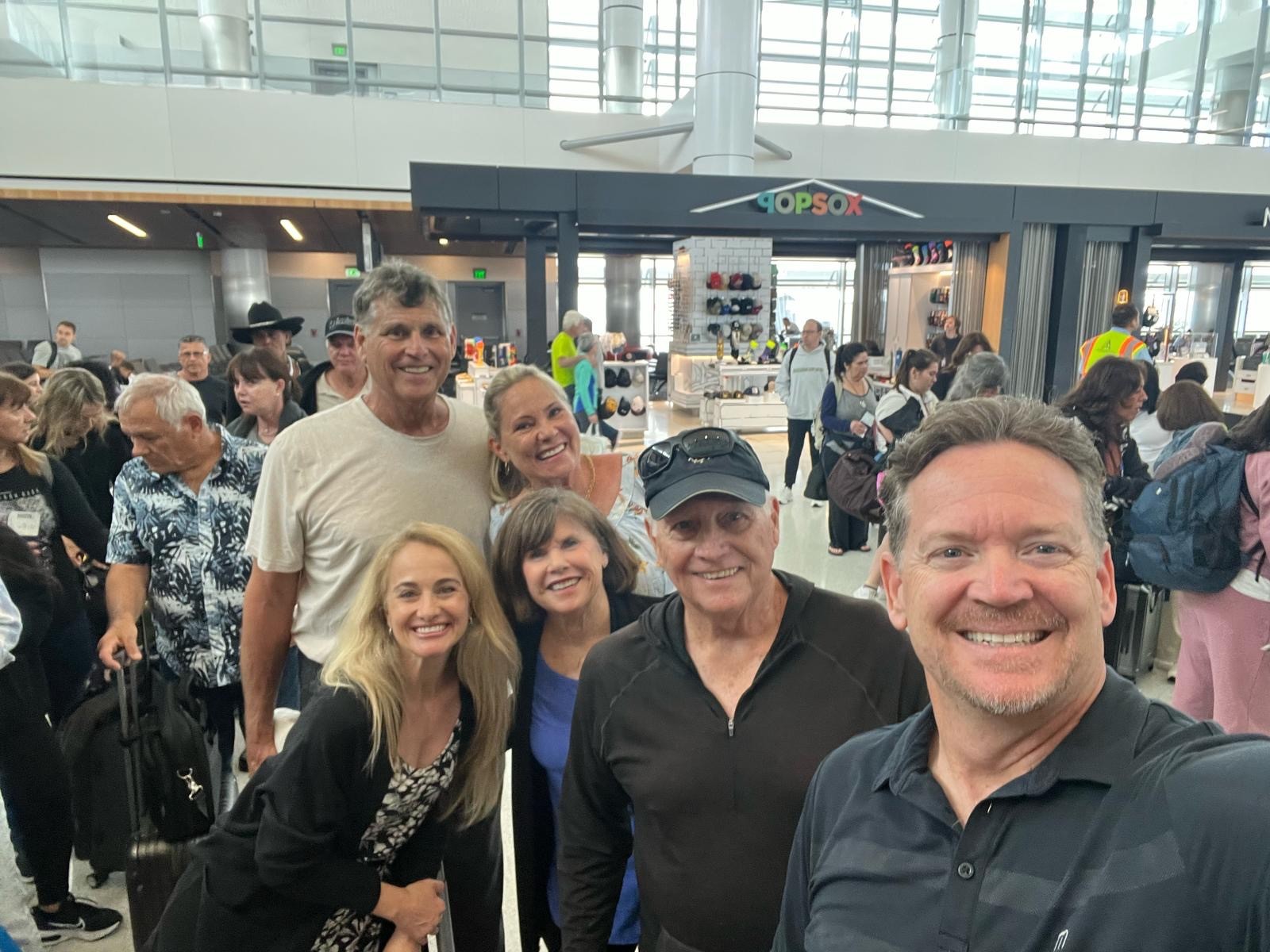A Journey of Faith, Persistence, and Perfect Timing
Our story begins not with suitcases and plane tickets, but with tragedy and the enduring power of love.
In 1969, Debbie’s parents were killed in a plane crash, leaving behind grief that would shape our family forever. But from that darkness came an unexpected light—their Jewish friends honored their memory by having olive trees planted in Israel, connecting our hearts to the Holy Land in a way we never could have imagined.
For decades, those olive trees grew in distant soil while a dream took root in our hearts: someday, we would walk the land where they were planted. Someday, we would honor Debbie’s parents by visiting the place their friends had chosen to remember them. And we would walk not only where those olive trees grew, but where Jesus Himself had walked—the very land where our Savior lived, taught, died, and rose again.
That someday would take fifty-six years to arrive.
Five Attempts, Five Disappointments
Our first attempt was with a group from our church about thirty years ago when they organized a trip to Israel. We were excited and ready to go. Then, just weeks before departure, our children came to us with a heartbreaking request: “Please don’t go.”
The Middle East was in turmoil, conflicts were brewing, and our children were terrified of losing us the way Debbie had lost her parents. Having experienced that devastating loss herself, Debbie couldn’t bear the thought of putting our children through the same ordeal. We canceled.
Two more times over the years, we planned and prepared, only to face the same pattern—Middle Eastern conflicts erupting just before our departure dates, making travel too dangerous. Each cancellation felt like another closed door, another delay in fulfilling our promise to visit those olive trees planted in memory of Debbie’s parents.
The fifth attempt three years ago nearly broke our hearts in a different way. We had been gifted a trip to Israel from retired California Senator Jim Brulte when we handed the leadership of Standing Stone Ministry into the capable hands of Dr. Jeremy and Jerusha Clark. Debbie cried with joy—she was so overcome with emotion at finally being able to go to God’s promised land. We were ready to go, bags packed, arrangements made, anticipation building. Then, just three days before departure, Debbie discovered she had a blocked carotid artery. Her doctor was firm: “You cannot travel.” Surgery was scheduled immediately. Our pilgrimage would have to wait once again.
We had another trip planned in 2023, but on October 7th, Hamas captured hostages and war broke out between Hamas and Israel, we knew this attempt, too, was not meant to be.
After each cancellation, we wondered if we were being foolish to keep trying. But deep in our hearts, we began to sense something profound: perhaps God was waiting to send us at exactly the right time. Looking back now, we believe that more than ever.
The Sixth Time: God’s Perfect Timing
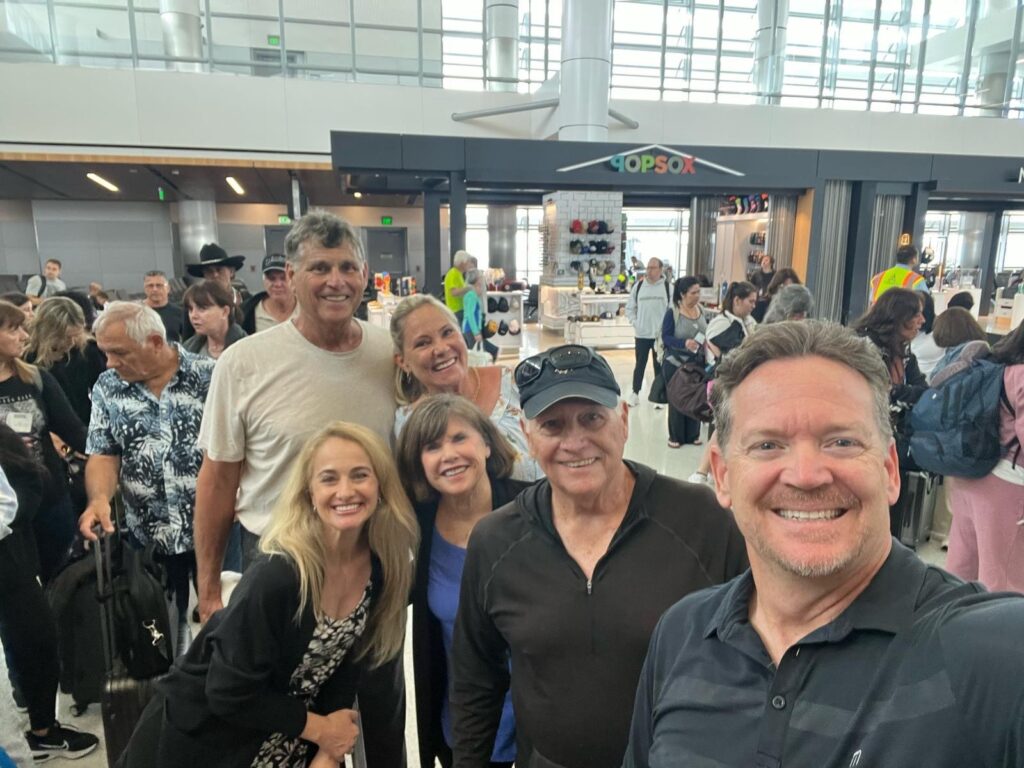
The sixth attempt turned out to be the charm. On June 8, 2025, after so many years of waiting, five cancellations, and countless prayers, we finally boarded that plane to Israel. We traveled with Jeremy & Jerusha Clark and April and Dean Miraldi. Jeremy and Jerusha are the current directors of Standing Stone Ministry. April is the retreat coordinator for Standing Stone and has been with the ministry for over 10 years, making her the most senior staff member. Her husband, Dean, is a former 6’6″ NFL football player. Not only do we work together but we have developed deep and meaningful friendships over the years. We all took off together at LAX and were given the name “The Stoners” on the trip. We couldn’t have asked for better companions on this epic adventure.
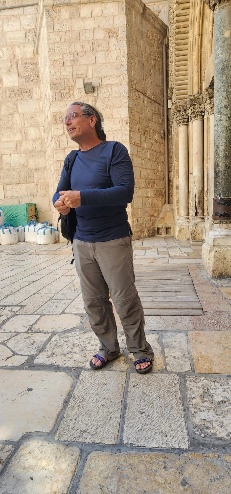
Upon arrival in Israel, we were greeted in Tel Aviv at Ben Gurion airport by our guide Jared Goldfarb, an Israeli citizen who had been born in New Hampshire but has lived in Jerusalem for over thirty years. He is a college professor and well-known tour guide with a deep knowledge of Israel’s history, both past and present. His expertise would prove invaluable in the days ahead. Immediately we drove from Tel Aviv to Jerusalem, not knowing that it would be the last time we saw this impressive city. We also met the rest of our group: Cheryl and Ally Pine, Martin and Micki Paine, Craig and Melanie Benedetto and their 13-year-old son Holden, John and Libby Nienstedt, and David Armanasco—all friends of Jim Brulte and very interesting people. Though we were strangers at the beginning, we would soon become lifelong friends bonded by the extraordinary experiences we were about to share.
Walking Where Jesus Walked
Before we started our journey through the ancient city of Jerusalem, Jared gave our group a sobering instruction: “Download this app called Red Alert. It will warn you if missiles are launched into Israel.”
We dutifully downloaded it, thinking we’d probably never need to use it. How wrong we were.
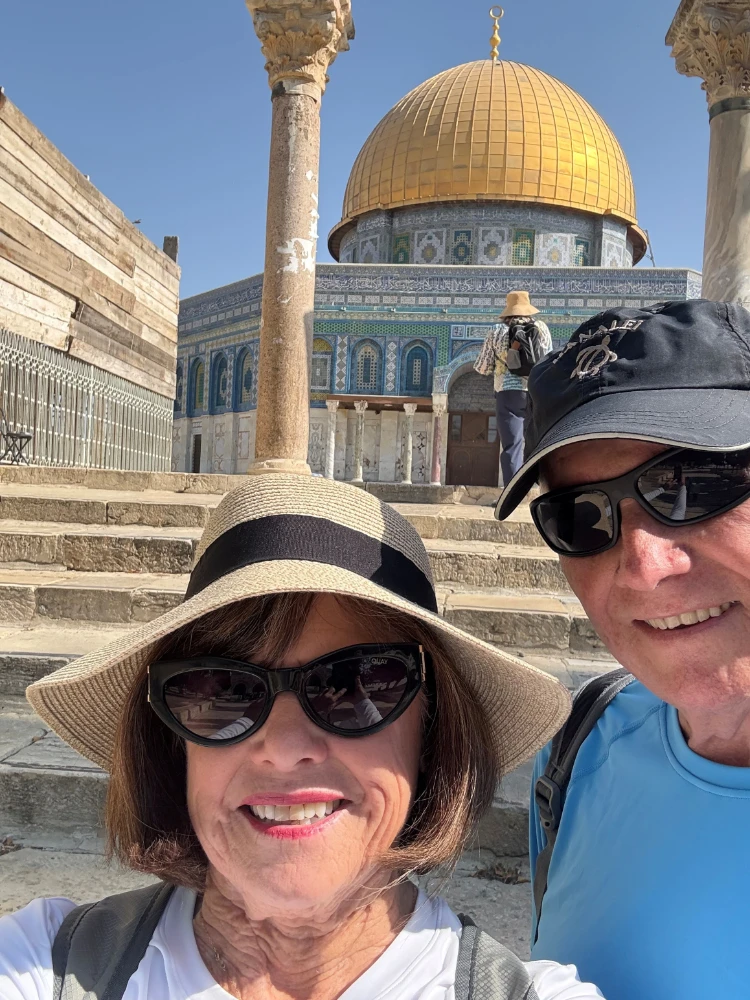
The next morning we boarded a bus for our first destination, the Temple Mount—the site of the first and second holy temples, now home to the Dome of the Rock and Al-Aqsa Mosque. Next we explored the City of David, the first capital of the Israelite kingdom and the original city where King David established his reign over all of Israel around 1000 BC. This is where it all began—where David brought the Ark of the Covenant and where his son Solomon would later build the first Temple on the mountain above.
We walked through Hezekiah’s Tunnel, an incredible feat of ancient engineering that King Hezekiah ordered to be carved through solid rock around 700 BC to bring water from the Gihon Spring into the city during the Assyrian siege. The tunnel is about 580 yards long and pitch black—if you’re claustrophobic, it’s not a place you want to be. Dean, who was behind Debbie in the tunnel at 6’6″, couldn’t believe he could fit through the narrow opening, and frankly, neither could we! Walking through this narrow, winding tunnel in knee-deep water, knowing we were following the same path that sustained Jerusalem’s inhabitants over 2,700 years ago, was absolutely amazing. We saw the Pool of Siloam where Jesus healed the blind man—the very destination of that remarkable tunnel. At the southern excavations, we walked through the ancient pilgrims’ entrance and saw where the marketplaces once bustled with activity.
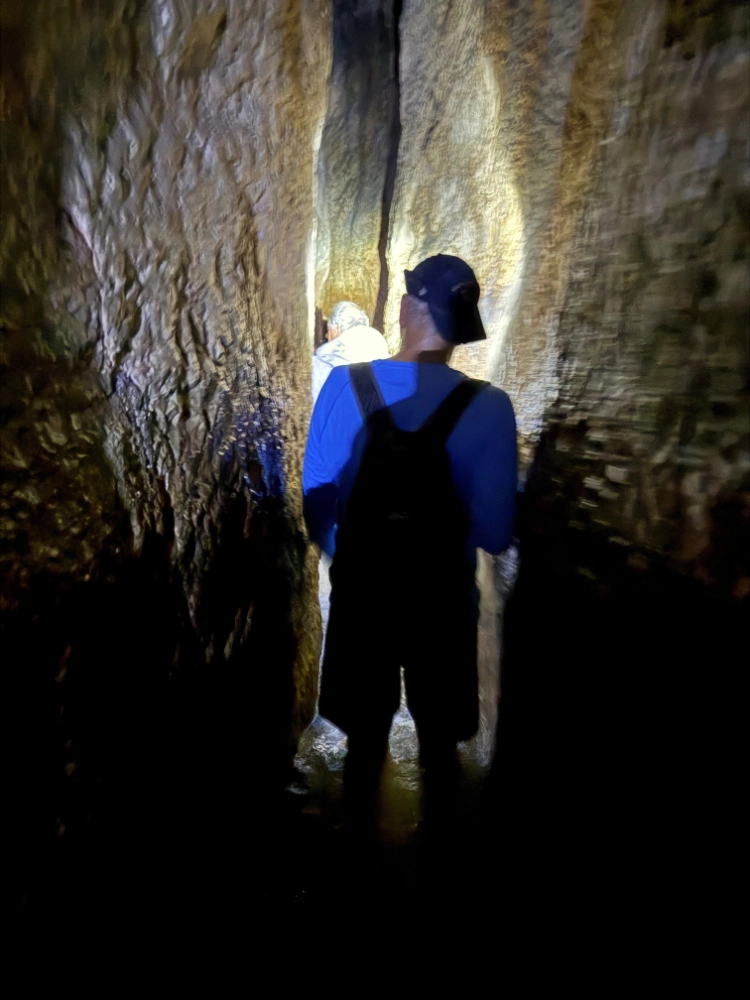
Standing at the Western Wall, watching people pray with such devotion, we were overwhelmed by the sacred history surrounding us and the countless prayers that have been placed in this ancient wall. We briefly explored the marketplace but decided not to purchase anything that first day, thinking we’d have plenty of time later. How naive that assumption would prove to be. That first day we walked over 16,000 steps, covering so much sacred ground.
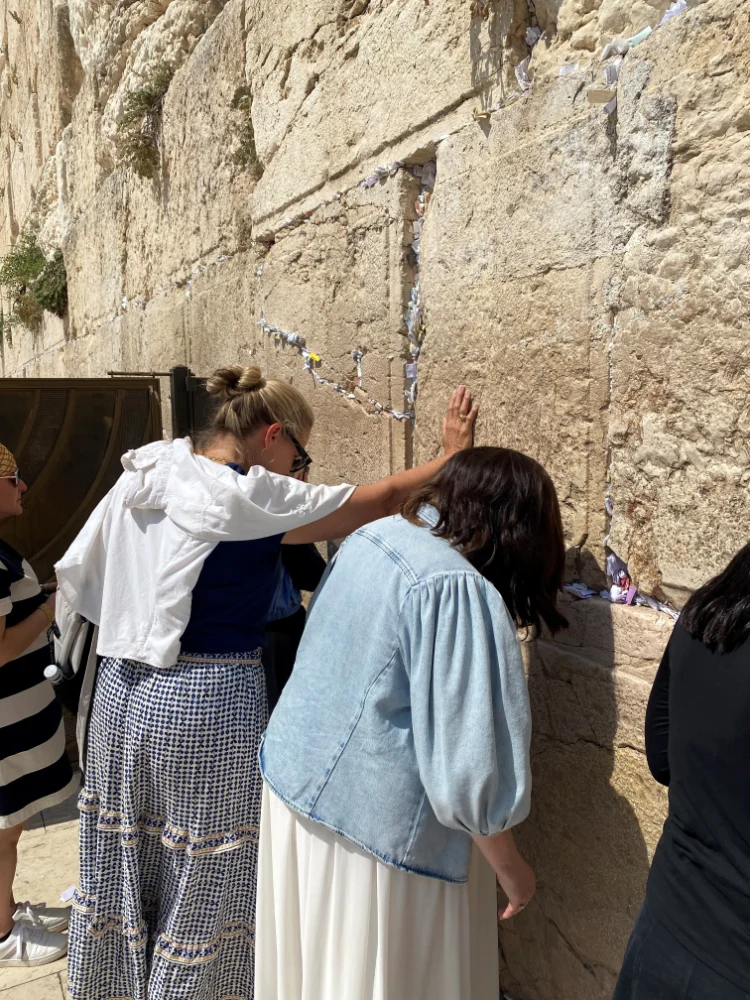
Throughout our time in Jerusalem, we were surprised at how uncrowded all the sites were. Normally these holy places would be bustling with pilgrims and tourists from around the world, but the ongoing conflict had dramatically reduced visitors. Israel’s economy is really suffering from this lack of tourism, since much of their revenue depends on the millions who typically come to walk in the footsteps of their faith.
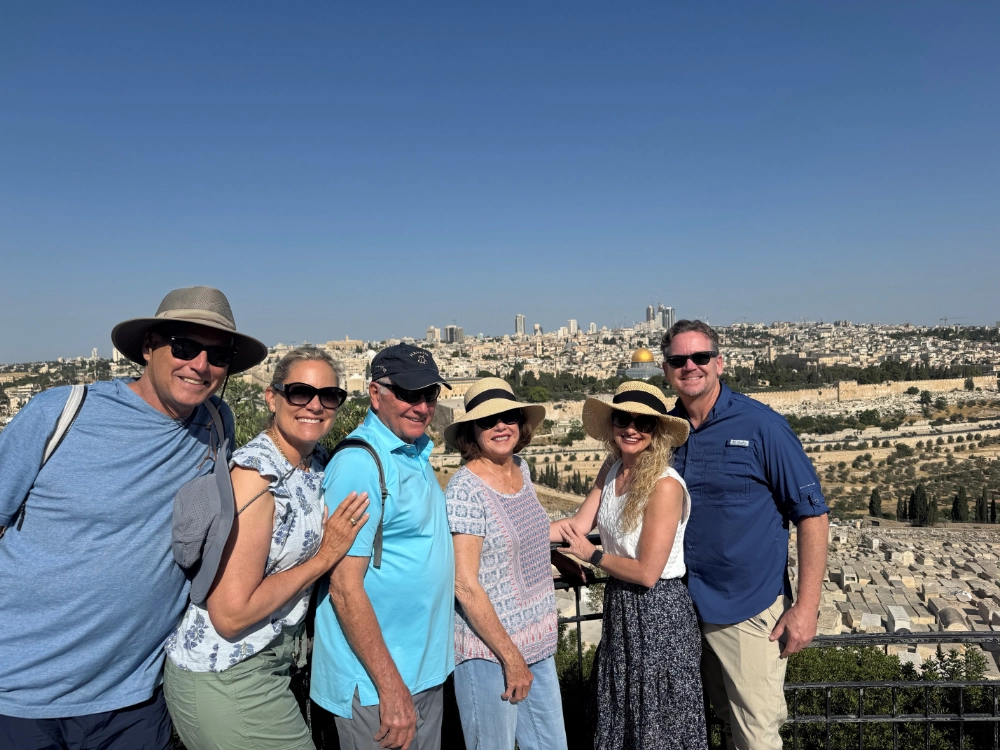
Wednesday morning brought us to the Mount of Olives, where Jesus ascended into heaven and where He is said to return. Upon our arrival, we were greeted by a small, weathered man with a gentle smile who, without a word, extended toward us a delicate sprig of rosemary intertwined with a fresh olive branch. We reached for our wallets, instinctively wanting to offer payment for this beautiful gesture, but he shook his head with a kind smile and refused any compensation. His gift was freely given from his heart. In that moment, something stirred deep within Debbie’s heart—a whisper of wonder, a flutter of possibility. Could this tender olive branch have come from one of the very trees planted in memory of her beloved parents? Could this weathered stranger, unknowing of our story, be an instrument in God’s gentle orchestration of our long-awaited visit to the Holy Land? We will never know for certain. The olive groves of Israel stretch across countless hillsides, each tree carrying its own history, its own purpose in the tapestry of this ancient city.
In the Hebrew tradition, the olive branch has always been a symbol of peace, dating back to Noah’s dove returning to the ark with proof that God’s judgment had ended and His mercy endured. As we carried that small branch through the streets where Jesus walked, we began to understand that our arrival was marked not just by the fulfillment of a dream, but by a benediction—a blessing spoken in the universal language of kindness by a man whose name we never learned but whose gentle spirit reminded us that God’s love often comes to us through the unexpected grace of strangers.
From here we retraced Jesus’s steps into Jerusalem, visiting the Church of Dominus Flevit, which means “The Lord Wept.” This beautiful tear-shaped chapel marks the spot where Jesus wept over Jerusalem as He prophesied its destruction. From its windows, you have a stunning view of the Old City and the Temple Mount, the same view Jesus would have seen as He mourned for His beloved city.
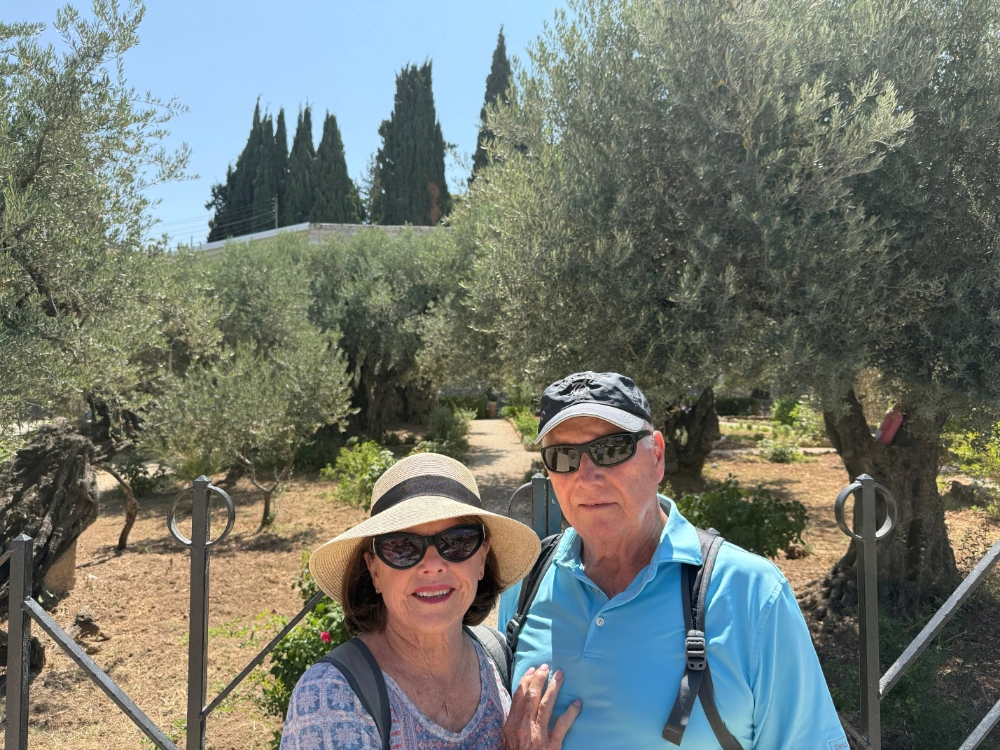
We then visited the Garden of Gethsemane, where Jesus went the night before His arrest. Standing in that garden was surreal—knowing we were in the very place where He wept tears of blood and asked God if there might be another way, yet ultimately surrendered to His Father’s will.
We also saw Golgotha, which means “Place of the Skull,” where many believe Jesus was crucified between two criminals. This rocky outcrop, located just outside the Garden Tomb area, has the haunting appearance of a skull when viewed from certain angles—eye sockets, nose cavity, and jaw line carved by wind and weather over time. Standing there, looking at this place of ultimate sacrifice where our Savior gave His life for our sins, was both heartbreaking and awe-inspiring. It’s here that Jesus spoke His final words from the cross, where darkness covered the land, and where the veil in the temple was torn in two from top to bottom.
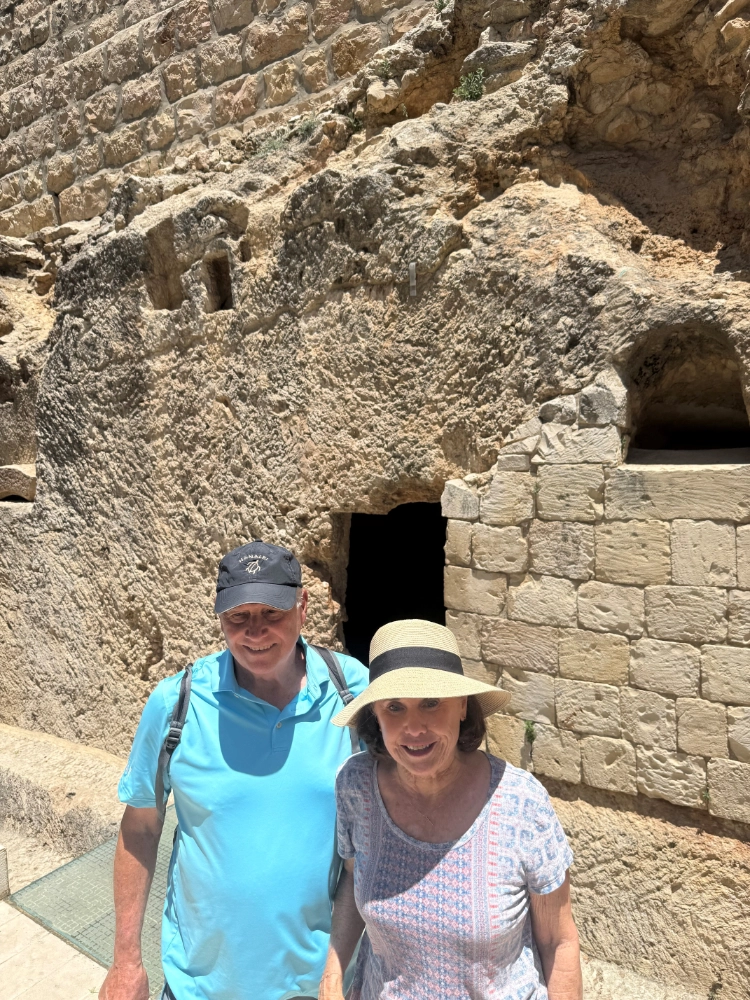
Next we visited the Garden Tomb, where we walked inside to see the empty tomb, surrounded by a beautiful garden that spoke of resurrection life. There, in that sacred place where Jesus had been buried but then rose again and appeared to His disciples, we experienced the most meaningful communion service of our lives.
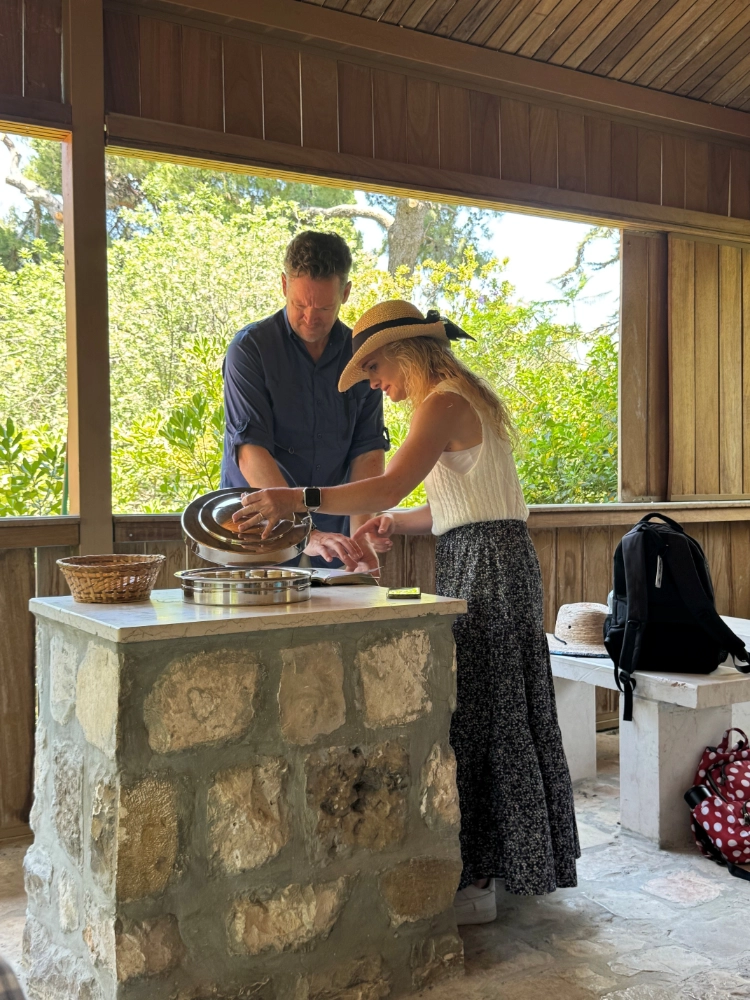
Jeremy and Jerusha led us in this profound moment, with Jerusha singing beautiful hymns as we received the elements—the bread broken for us and the wine representing the blood shed for our sins, so that we might be forgiven forever. Taking communion in the very place of Christ’s resurrection was beyond words.
Upon leaving we bought our family crosses made from olive wood that say “He Is Risen” on one side and “Jerusalem” on the other. Little did we know these would be our only souvenirs from our time in this holy city. But these simple crosses will hold more meaning than any treasure we could have imagined.
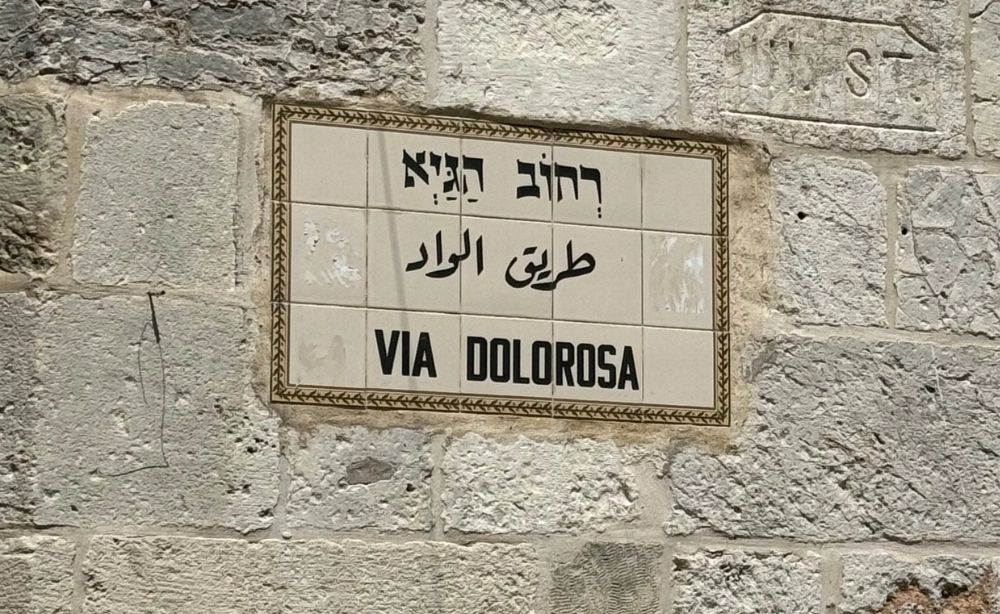
After lunch at Jared’s favorite vegan restaurant, we walked the Via Dolorosa, Latin for “Way of Sorrows” or “Way of Suffering”—the traditional route Jesus took carrying His cross from His condemnation by Pontius Pilate to His crucifixion at Calvary. This narrow, winding path through the Old City follows fourteen Stations of the Cross, each marking a significant moment in Jesus’s final journey. We paused at each station as Jeremy and Jerusha eloquently brought Scripture to life, helping us understand Jesus’s suffering in ways we’d never grasped before. Walking these ancient cobblestones, surrounded by the same limestone walls that witnessed His agony, we could almost feel the weight of the cross, hear the jeers of the crowd, and sense the love that drove our Savior to endure such pain for our salvation. The Via Dolorosa isn’t just a tourist route—it’s a pilgrimage that transforms your understanding of what Jesus endured for us.
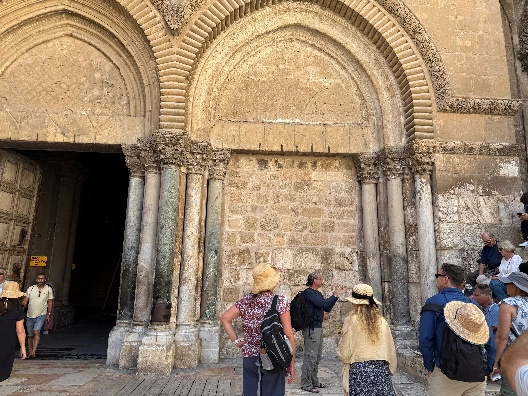
Our day ended at the Church of the Holy Sepulcher, the traditional site of His crucifixion, burial, and resurrection. This ancient church, built over what many believe to be Calvary and Christ’s tomb, is one of Christianity’s holiest sites. The moment you enter, you’re struck by the weight of history and faith as you see pilgrims from around the world coming to touch the stone where many believe Jesus’s body was prepared for burial, to kneel at the site of crucifixion, and to enter the small chapel built over His tomb. The church is shared by several Christian denominations, each maintaining their own areas and conducting their own worship services. Despite the crowds and the sometimes overwhelming atmosphere, there’s an undeniable sense of the sacred here. Standing in this place where our Lord conquered death itself, where the greatest victory in human history took place, was deeply moving and brought our walk through Jesus’s final days to its triumphant conclusion.
That night, everything changed. At 3:30 AM, we received our first Red Alert.
War Comes to the Holy City
The piercing sound of that alarm will be forever etched in our memory. We quickly made our way from the fifth floor down the staircase to the bomb shelter, avoiding the elevator as instructed during siren alerts. The shelter was a massive basement area, two floors below ground, that normally served as the hotel’s dining room. It was filled with hotel guests and local residents, families with children and pets, all seeking safety together. Many of these people became friends over the coming trips to the bunker. We stayed for thirty minutes until the all-clear signal. At 5:30 AM, another alert sent us back to the shelter for another thirty minutes. This started our first night of sleep deprivation because sleeping was tough between our sprints to the shelter.
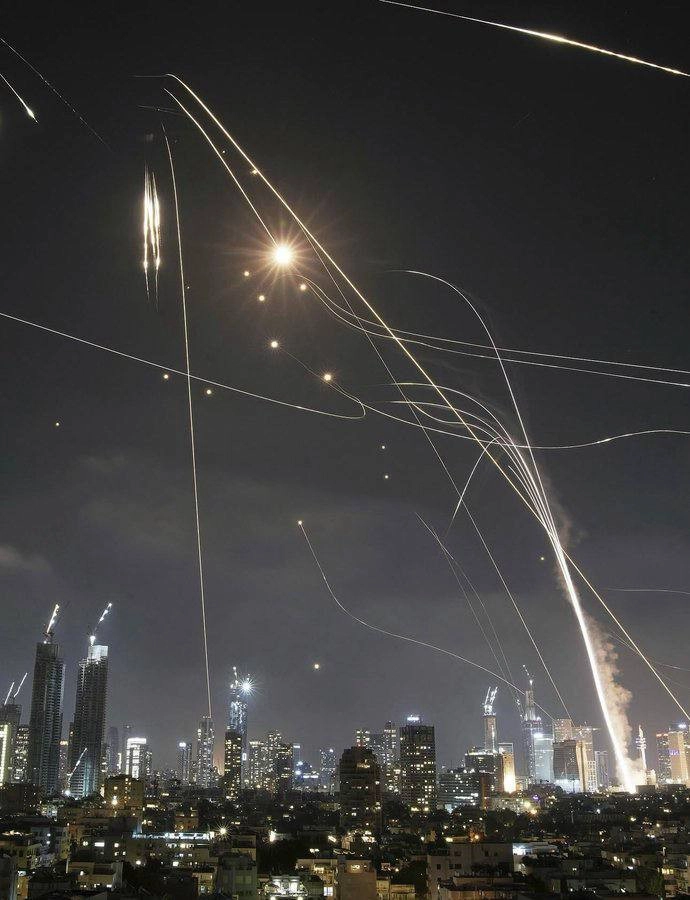
Despite the tension, we continued our planned trip to Masada, King Herod’s engineering marvel atop a mountain, where Jewish rebels made their final stand against Rome. From there, we went to the Dead Sea, the lowest and saltiest body of water on earth. Sadly, the Dead Sea is literally dying because so many minerals are being mined and the water that feeds it has been cut off. Floating in those mineral-rich waters was an incredible experience—you feel like a cork bobbing on the surface. Debbie loved it; Jim, not so much.
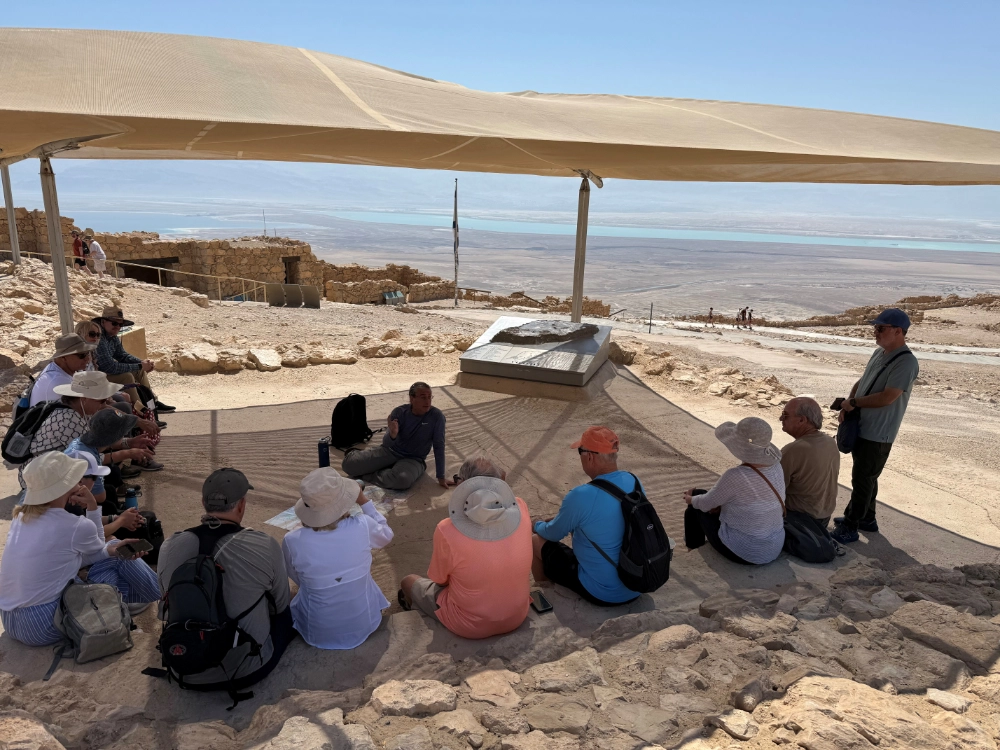
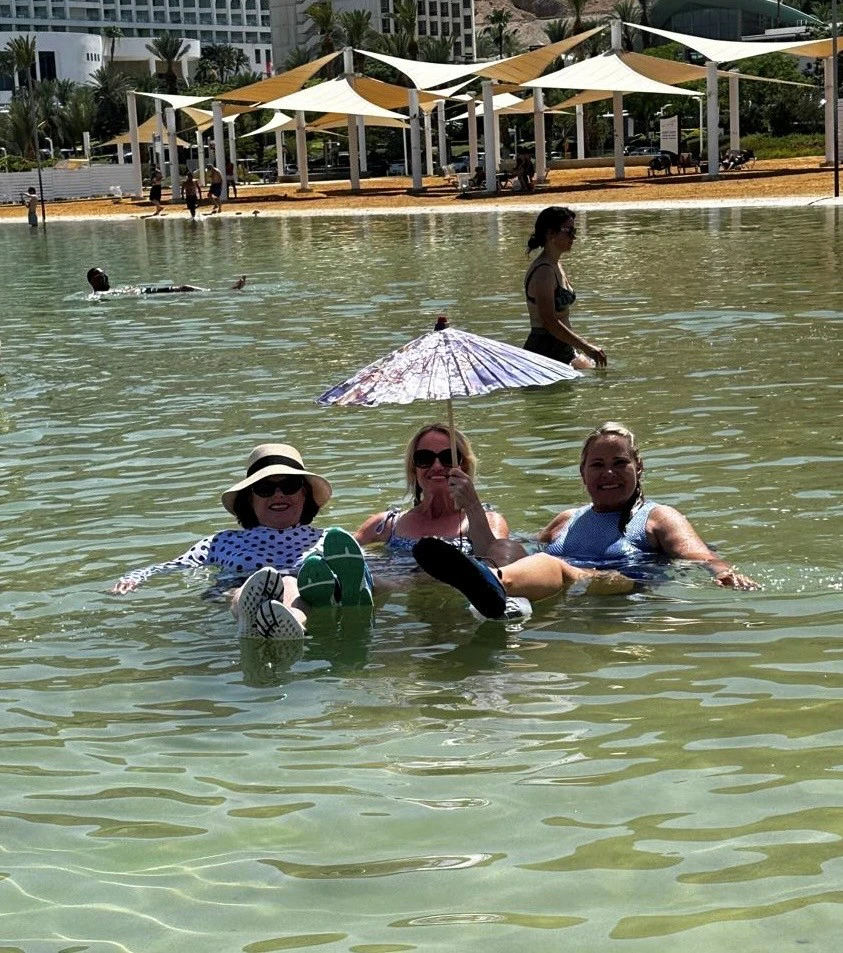
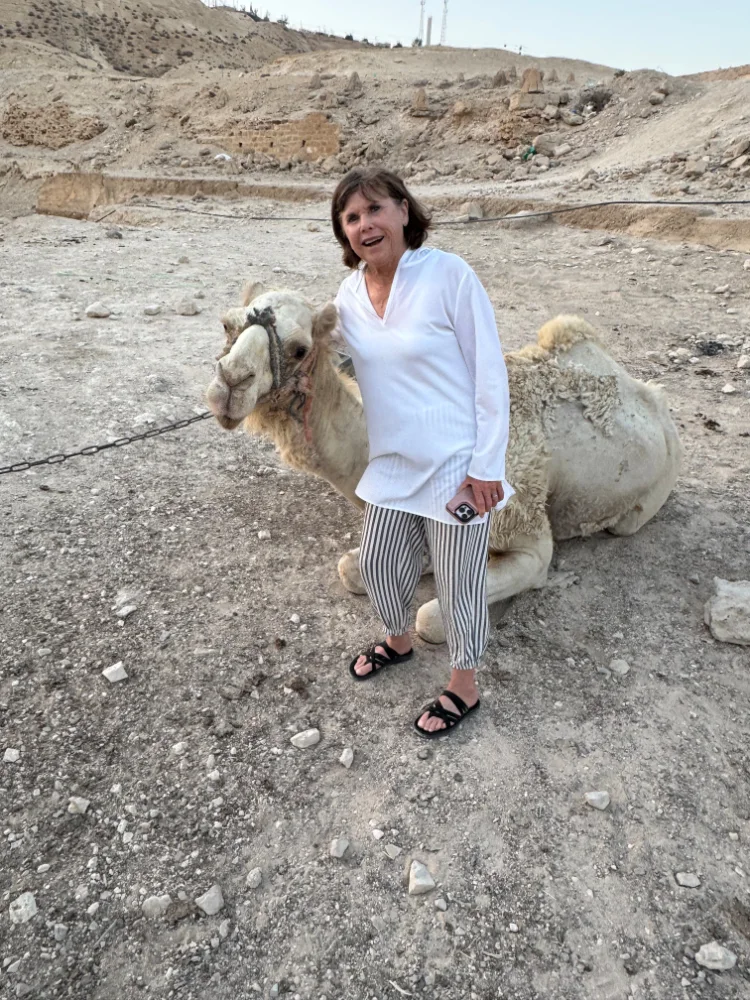
Our day concluded with a visit with Jared’s friend Jamil, a Bedouin who hosted us for a traditional feast in his luxurious tent, complete with carpets and chandeliers. While we were with Jamil, he told us about the plight of the Bedouins—the traditional nomadic Arab people who have roamed the deserts of the Middle East for centuries. Many Bedouins today struggle to maintain their ancient way of life as modern borders and development encroach on their traditional grazing lands. They face challenges with land rights, access to education and healthcare, and preserving their rich cultural heritage while adapting to the modern world. Despite these hardships, Jamil’s hospitality and warmth exemplified the Bedouin tradition of welcoming strangers as honored guests. The highlight of our visit with Jamil was Debbie getting to pet one of his camels who seemed to genuinely love her—perhaps she’s a camel whisperer!
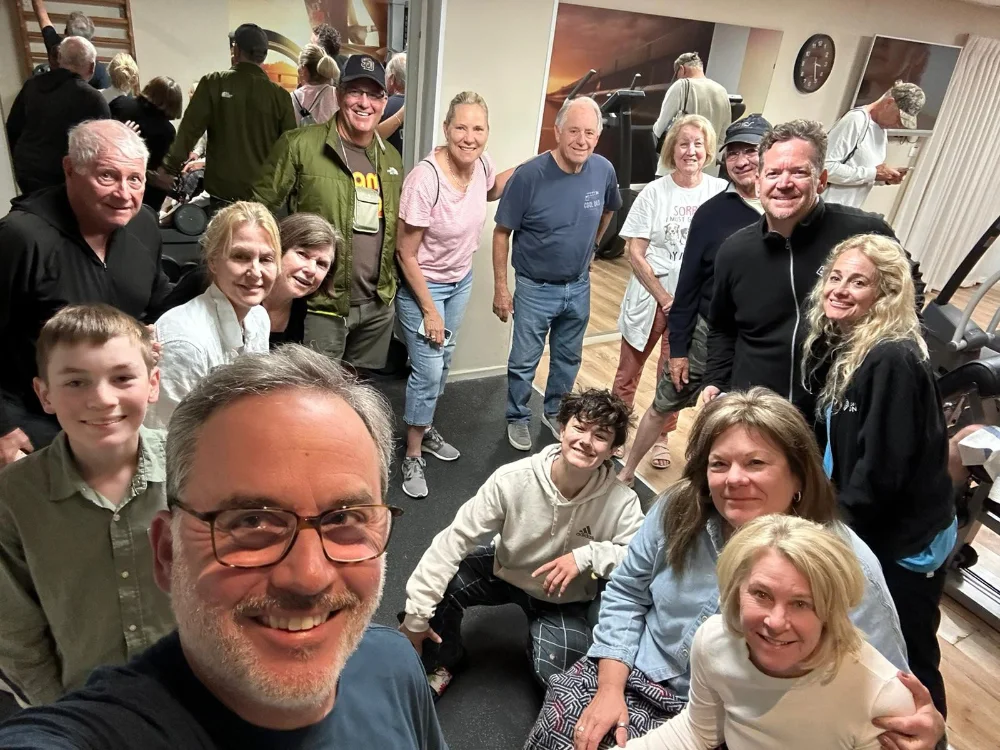
That night brought two more alerts at 1:00 AM and 3:30 AM, making sleep nearly impossible. During one of the raids, some of the men in our group decided to go up on the hotel rooftop and took amazing but terrifying pictures of rockets being shot and then intercepted. It gave us a new understanding of our national anthem’s words: “the rockets’ red glare, the bombs bursting in air.”
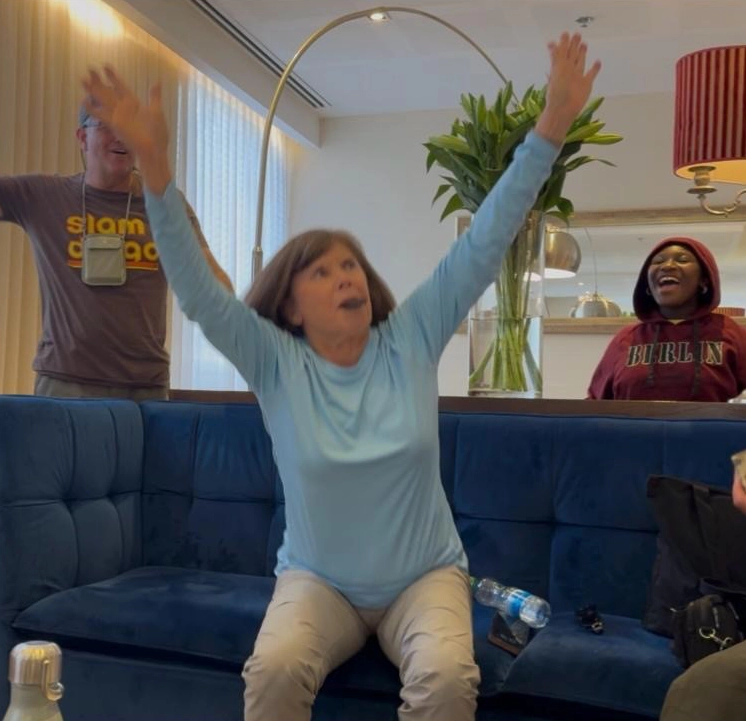
The following day, the rest of our group arrived: Jim Brulte, his wife Kirsten and their 11-year-old daughter Ivy, Kirsten’s sister Shawna, Josh, Robin and their 18-year-old daughter Mokie, and Luis and Dee Buhler. All of us were finally together. However, Jerusalem was put on lockdown—no one could leave the area. So sadly they weren’t able to see this incredible and historic city. It ended up being a much needed day of rest because we were exhausted from the last three days. We spent the next two day in the hotel, lounging around chatting, eating, and playing card games, so grateful for the downtime. Debbie entertained everyone by doing her famous Oreo cookie trick, getting it from her forehead into her mouth without using her hands.
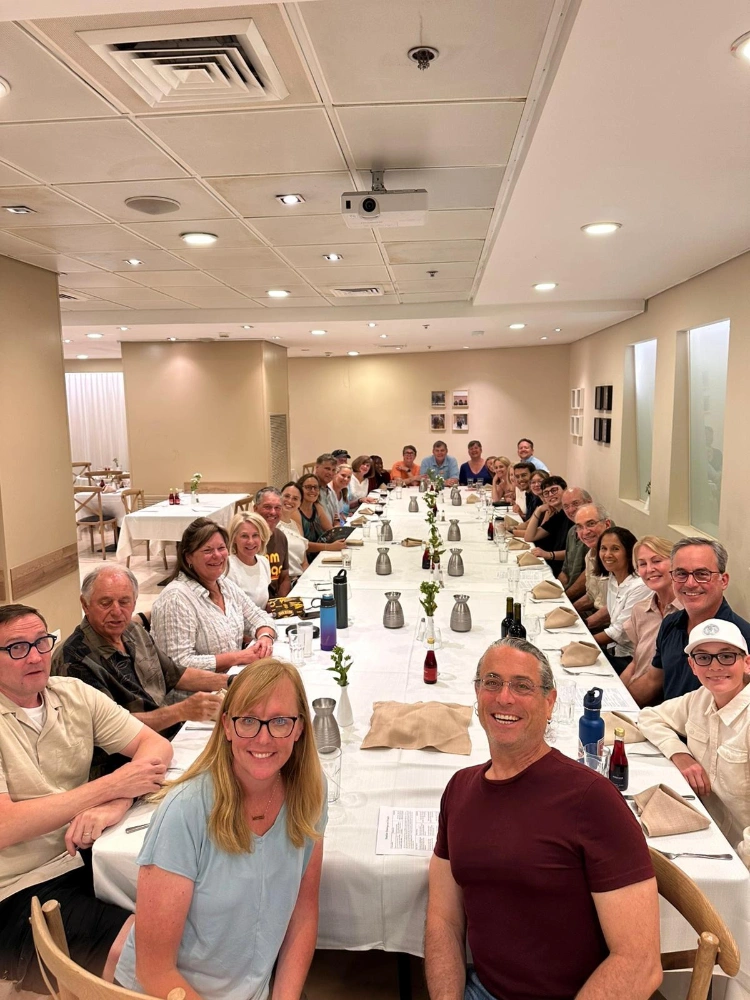
Friday evening brought us an unexpected and deeply moving experience that would become one of the most treasured memories of our entire journey. Jared, our Orthodox Jewish guide, invited our group to share a Seder dinner with him and his family in the hotel—conveniently located in the bomb shelter where we had already spent so much time together seeking safety.
A Seder is a ceremonial dinner that marks the beginning of the Jewish Sabbath every Friday evening, but it holds its deepest significance during Passover when it commemorates the Israelites’ liberation from slavery in Egypt. The word “Seder” means “order” in Hebrew, referring to the specific sequence of prayers, readings, songs, and symbolic foods that tell the story of God’s deliverance of His people. In our Friday evening Seder, we experienced the sacred rhythms that have bound Jewish families together for thousands of years.
As we gathered around the table in that underground space that served as both dining hall and bomb shelter—we were struck by the profound symbolism. Here we were, breaking bread with a Jewish family in the very place where we sought refuge from modern-day threats, just as their ancestors had sought deliverance from Pharaoh’s oppression millennia ago. Jared explained each element of the meal, sharing the ancient prayers and stories that connect every Jewish family to their heritage and to God’s faithfulness throughout history.
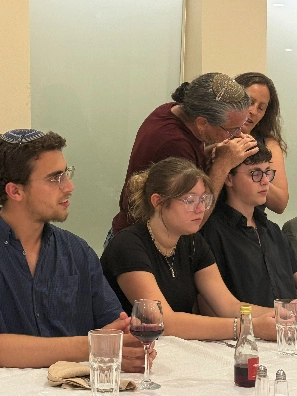
But the most sacred moment came when Jared and his wife moved around the table to bless their own children—young adults now, their eldest daughter and two sons, one of whom was serving in the Israeli Army. With tender hands placed upon their children’s heads, they spoke ancient Hebrew words of blessing. Following their beautiful example, Jim and Kirsten laid hands on their eleven-year-old daughter Ivy, and Craig and Melanie blessed their thirteen-year-old son Holden. The ancient Hebrew words of blessing filled that underground room as parents called down God’s protection, wisdom, and favor upon their children.
There wasn’t a dry eye at the table. In that moment, we witnessed something timeless and sacred—the passing of faith from one generation to the next, the same tradition that has sustained the Jewish people through centuries of persecution and wandering. As Christians, we were deeply moved to see this living connection to the very traditions that Jesus Himself would have observed. We were experiencing the faith of Abraham, Isaac, and Jacob in its most intimate form—a family gathering to remember God’s faithfulness and to bless the next generation.
The juxtaposition was overwhelming: here we sat in a bomb shelter, surrounded by the uncertainty of war, yet participating in a ceremony that has remained unchanged for thousands of years. It reminded us that God’s people have always found ways to worship, to remember, and to bless their children, even in the darkest of times. That Seder dinner became a bridge between our faiths, showing us that despite our different understandings of the Messiah, we serve the same God who delivered the Israelites from Egypt and who continues to watch over His people today.
Escape to Eilat and Jordan
That night the decision was made to leave Jerusalem and head south. Once again our sleep was interrupted with the sound of sirens at 1:00 AM and 3:30 AM, making sleep nearly impossible. We were told that the sirens would sound at least 2 minutes before the missiles arrived, but at 3:30 we could hear the bombs exploding as we exited our room. This was the first time we were a little afraid. We flew down those seven stories in record time!
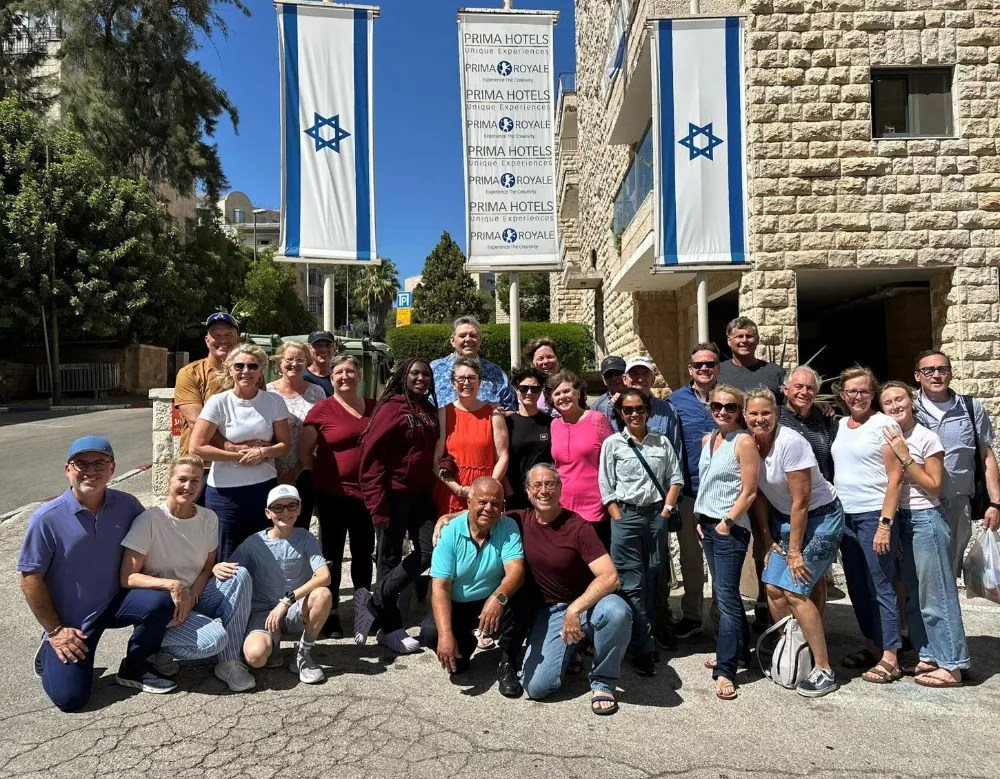
The following afternoon, before boarding the bus to Eilat, Jared informed us that he wouldn’t be joining us in Jordan (Israeli citizens weren’t allowed to leave the country at that time). We were all so sad and disappointed that our guide who we had grown to love would be leaving us.
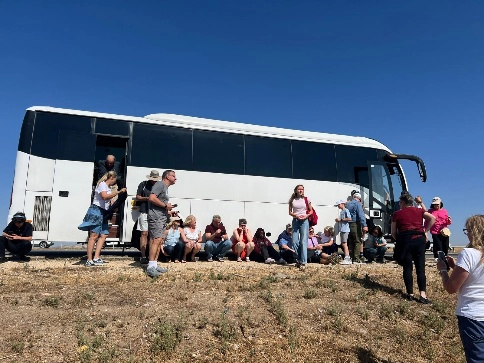
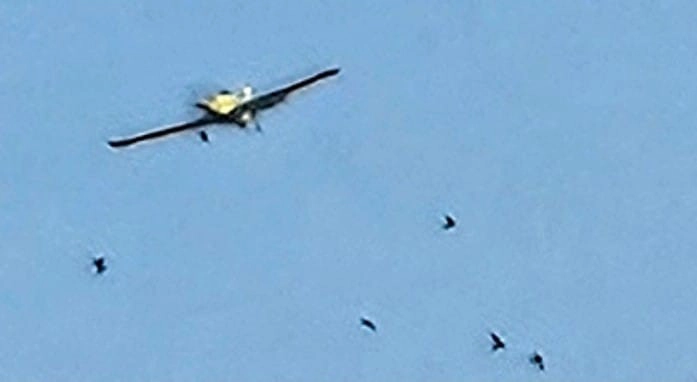
Halfway through our three-hour bus ride, we received another Red Alert. Our bus pulled to the side of the road, and we all had to exit and get to the lowest point we could find—a ditch by the roadside. We were alarmed to see two small planes circling overhead, particularly since all Israeli airspace was supposed to be closed. We were relieved when after circling the bus, the planes flew away. We’ll never know what they were doing but suspect they were Israeli spotter planes. Relieved, we got back on the bus and continued our journey.

We made another stop to eat at what was surprisingly a Mexican fast food restaurant in the middle of the desert. The burrito was actually quite tasty. There were several stray cats and dogs looking for a handout, thou they actually looked pretty well fed. As we drove back onto the highway we stopped at a beautiful overlook and were greeted by a mother Ibex and her baby who let us get very close to them.
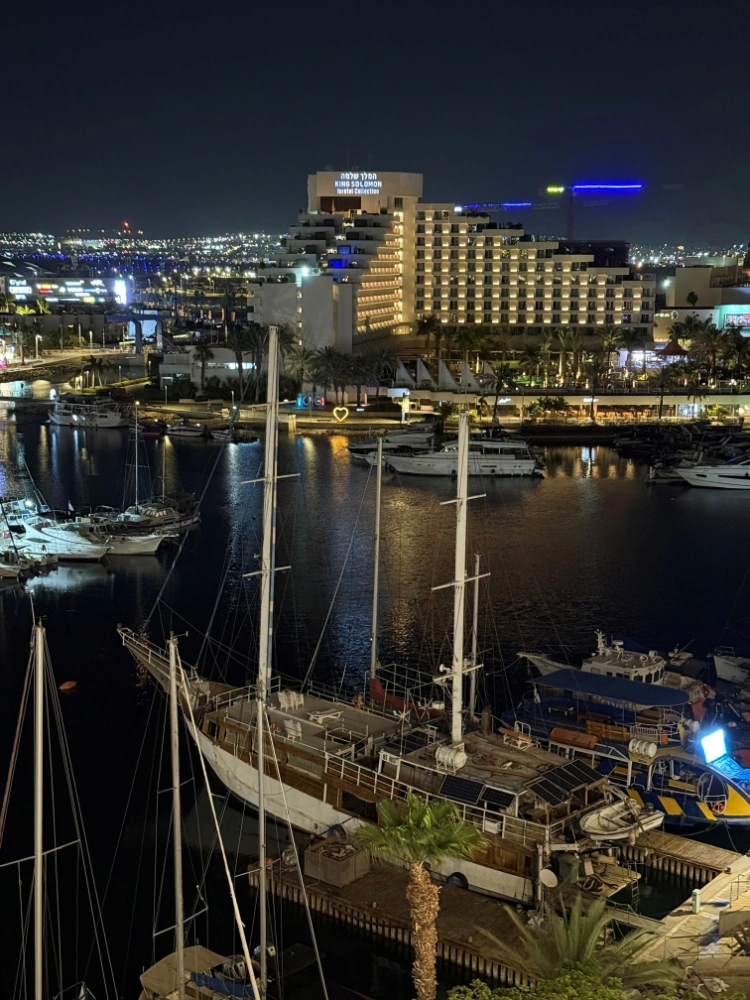
At our beautiful hotel in Eilat on the Red Sea, we thought we might finally be safe and get a good night’s sleep. From our balcony we had an amazing view of the marina full of luxury yachts. However, at 3:00 AM, another alert proved us wrong, sending us to shelters that looked like nothing more than linen closets on each floor. To be honest, we didn’t feel very protected and were relieved to get the all clear signal and return to our room though falling back to sleep was impossible.
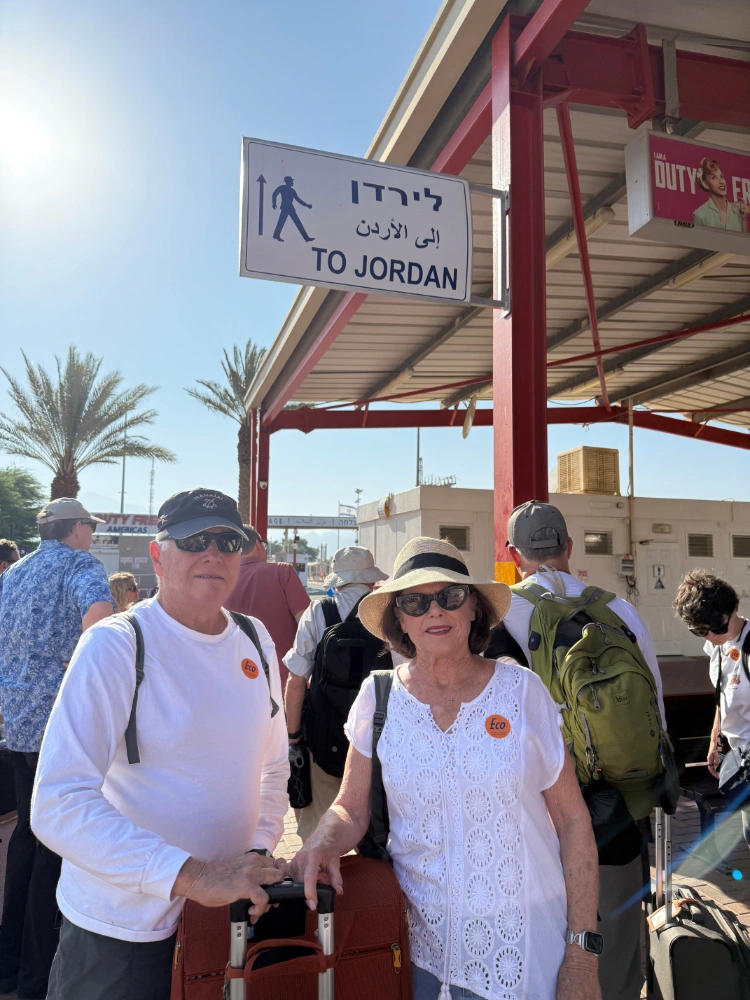
The next morning, we traveled to the Jordanian border where we exited the bus since vehicles cannot cross the border. Jared walked us to the border crossing and we said a tearful goodbye to the man who had fearlessly led us and made us feel as safe as possible under impossible circumstances. We are forever thankful for his confident and abundant leadership during such an uncertain and nerve wracking time. The following day he confessed to us on WhatsApp (which was the lifeline we used to communicate throughout the trip) that this was the most harrowing and stressful time he had ever experienced. He was returning to his kibbutz in the region while we crossed into what we hoped would be safer territory. Jared assured us it would be a safer place for him to get some much deserved and needed rest and recuperation. However, rest for him would have to wait. Others had heard about his success in leading us safely out of Israel. He was asked to take two other groups out of harms way, one through Jordon and the other through Egypt.
Finding Peace in Jordan
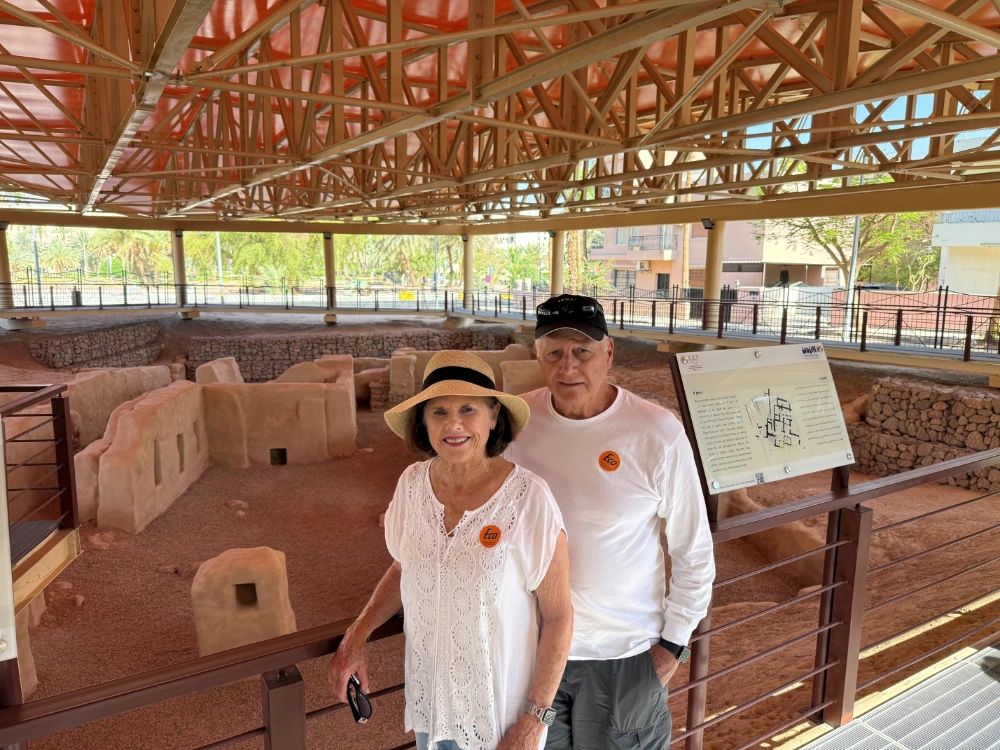
A Jordanian tour guide and armed guard greeted us, who both stayed with us throughout our time in Jordan. We boarded an air-conditioned bus for the journey to our first destination – the ruins of what is believed to be the world’s oldest purpose-built Christian church, the Aqaba Church, dating from 293-303 AD. This extraordinary archaeological site, discovered in 1998, offered us a fascinating glimpse into the origins of Christian practice. Walking through these ancient ruins where some of the earliest Christians worshipped was deeply moving, especially knowing we were standing in a place that predates even the Church of the Holy Sepulcher in Jerusalem.
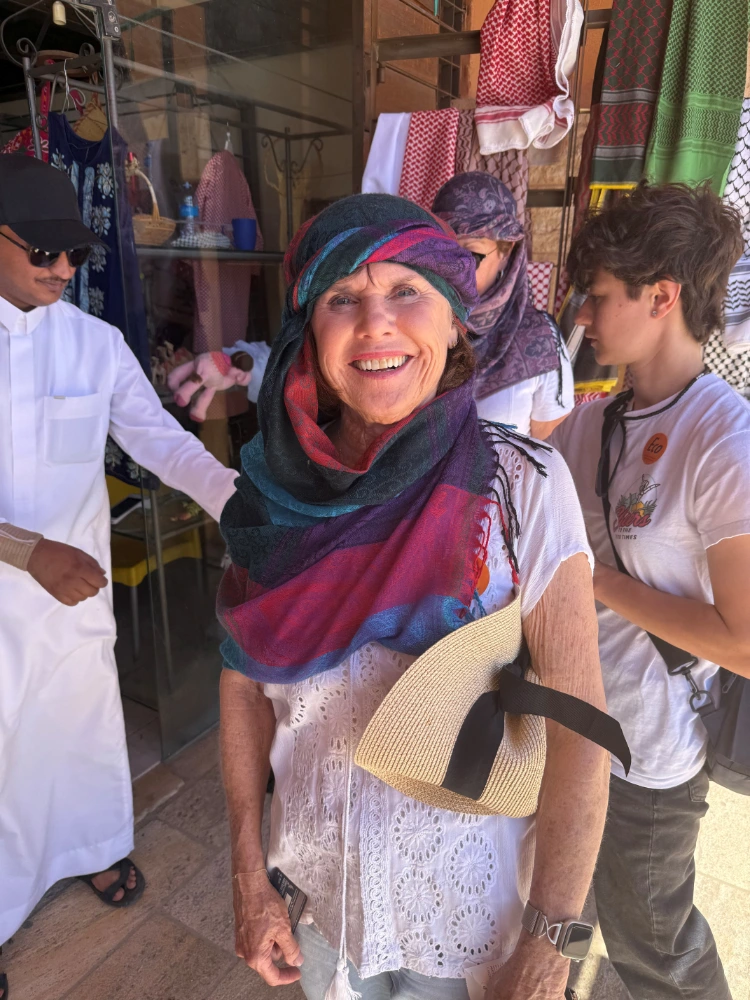
From there, we traveled to Wadi Rum, where Bedouins in open jeeps took us on a tour of the stunning desert landscape where Lawrence of Arabia, Dune, and Star Wars episodes were filmed. Before we started our tour, Debbie bought a scarf and had the shop owner put it on her head in the traditional Arab style—it proved helpful in keeping away all the dust from our jeep adventure. The desert was breathtaking with very fine bright orange sand, beautiful rock formations, and majestic sand dunes stretching as far as the eye could see. We saw incredible rock formations and 4,000-year-old petroglyphs, remarkably well-preserved thanks to the desert climate. A highlight of our desert tour was Debbie getting to ride a camel, another item checked off her bucket list!
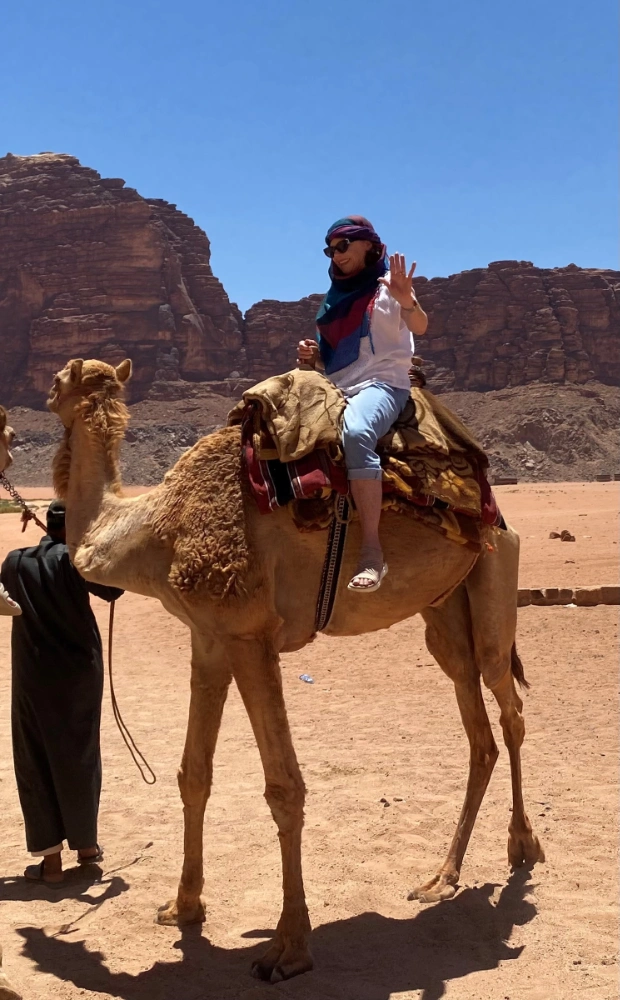
During a sunset tour, we found a spot with cell reception where everyone frantically called home. Our families had been so worried, and they desperately needed to hear we were safe. We talked to both our sons, and Debbie spoke with our granddaughter Brooke, who we knew was especially concerned about us. While we made our calls, our Bedouin friends made us tea and coffee in the middle of the desert—a surreal but beautiful moment.
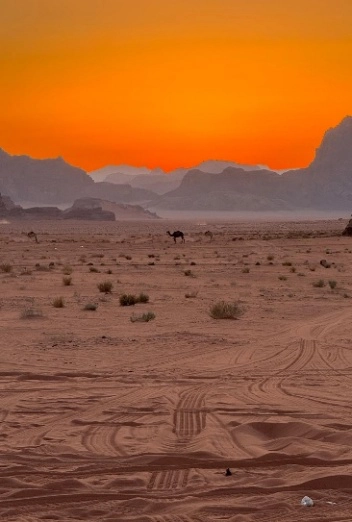
That evening, we enjoyed an amazing dinner that was cooked in the ground for hours—tender chicken with potatoes, squash, and onions. After we finished eating we went out to star gaze in the sky that was bursting with stars, so bright because there was no light pollution to dim their brilliance. One of our group had an astronomy app, and when we pointed it to the sky, we were overwhelmed by the countless stars visible above us. The biggest and brightest constellation visible was the Lion of Judah—incredibly appropriate given that Israel’s military operation against Iran was called “Rising Lion,” named after the Biblical passage in Numbers about Israel rising like a lion to confront its enemies. In that moment, under the vast desert sky filled with God’s creation, we felt He was reminding us of His omnipotent power and sovereignty over all nations and conflicts. We spent the night in luxurious tents, a far cry from roughing it in the desert. As we lay there, we could hear fighter jets flying overhead, a stark reminder of the conflict we had left behind.
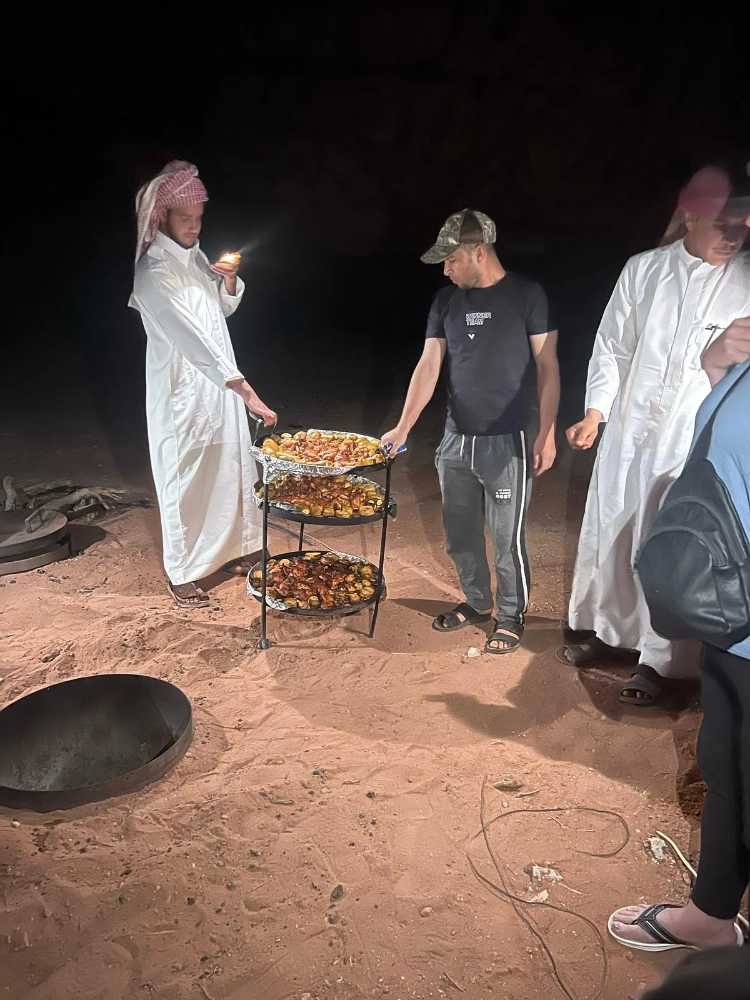
Petra and Mount Nebo
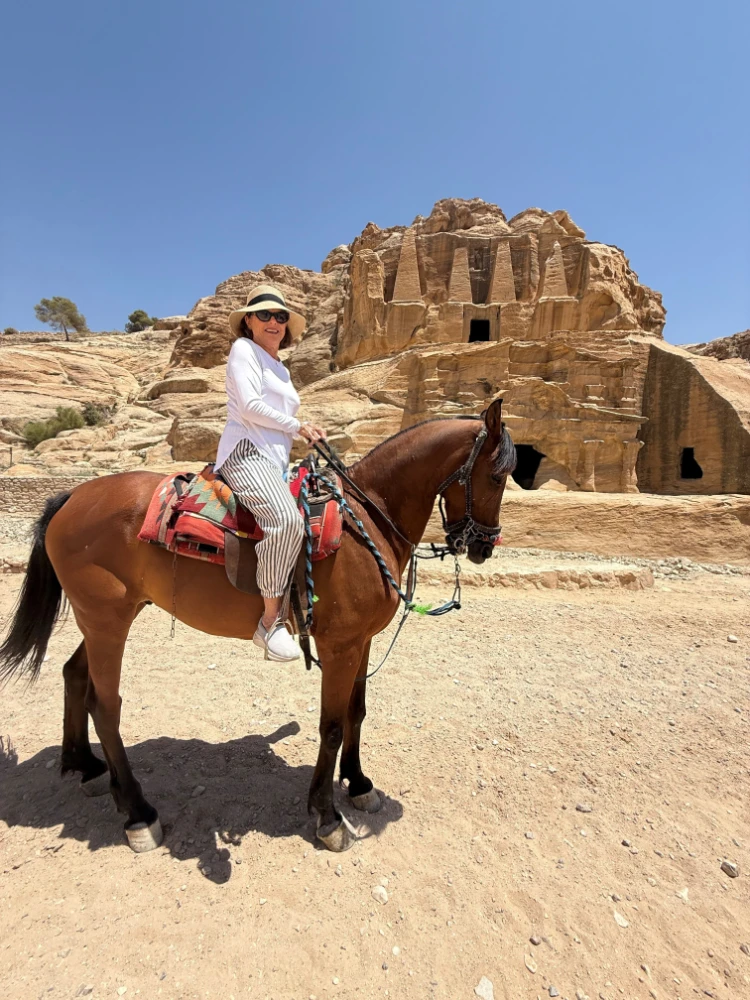
Another item on our bucket lists was fulfilled when we visited Petra, the ancient Nabatean city carved directly into rose-red sandstone cliffs. This archaeological wonder, hidden from the Western world until Swiss explorer Johann Ludwig Burckhardt rediscovered it in 1812, had captured our imaginations for decades. Our journey to Petra began with Debbie riding a horse—the owner was struggling financially due to the lack of tourism caused by the conflict, having difficulty supporting his wife and three children. Not only was Israel suffering from the lack of tourists, but the entire region was feeling the economic impact of the war, with Jordan’s tourism-dependent communities bearing a heavy burden.
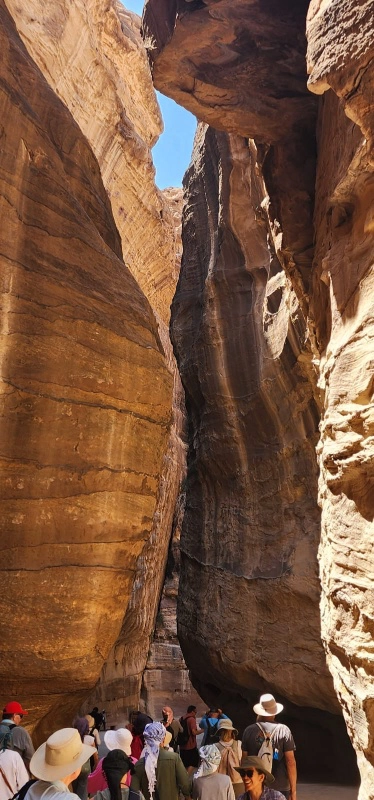
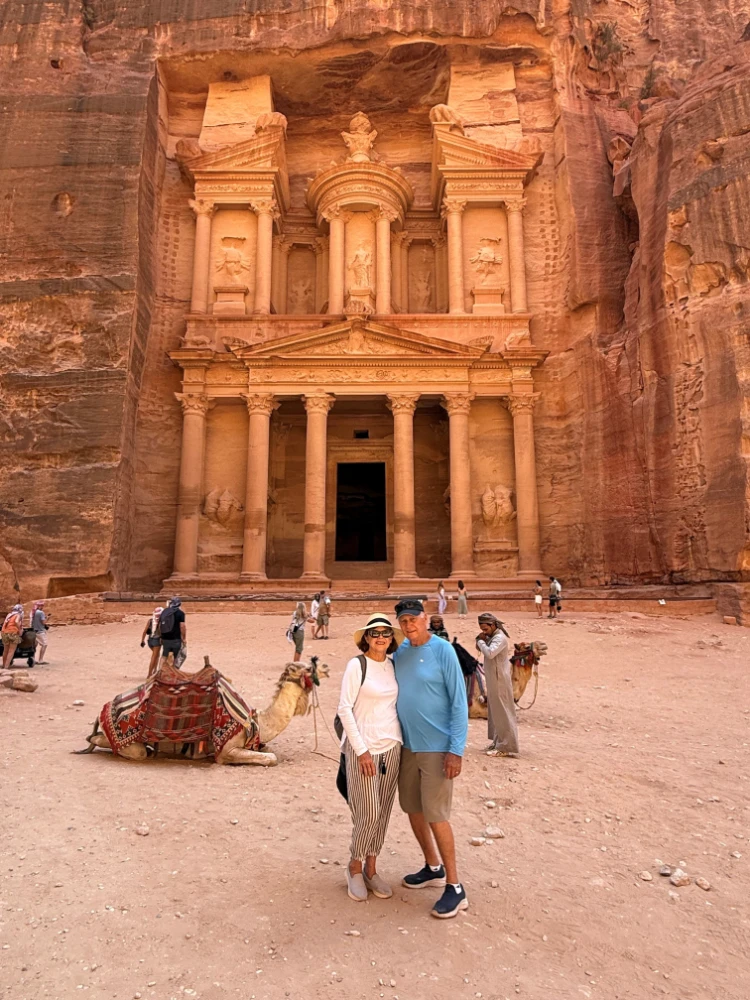
Walking through Petra’s narrow valley called the Siq, with towering cliffs on either side—sometimes only twenty feet wide—we felt dwarfed by the massive walls that seemed to stretch endlessly toward heaven. The anticipation built with every step as we made our way through this natural corridor that winds for over a mile. Then, at the end of the narrow passage, we caught our first glimpse of Al-Khazneh, the Treasury, emerging from behind the canyon walls. The moment was absolutely breathtaking—this magnificent facade, over 130 feet tall, carved with incredible precision into the living rock face nearly 2,000 years ago. We stood there in complete awe, trying to comprehend the skill and vision of the Nabatean people who created this masterpiece. The ancient engineering and artistry were beyond imagination, and we understood why Petra is considered one of the New Seven Wonders of the World.
That night in our Amman hotel, we were surprised to receive yet another alarm and alert of possible incoming missiles. Though the hotel assured us we would be safe, it made us feel uneasy. We were once again reminded that we were in a war zone as the haunting sound of the siren disrupted our sleep. Thankfully, this would be the last time we would hear that piercing alarm. However, it’s sound is forever etched in our memories, a reminder of the danger God protected us from throughout our journey.
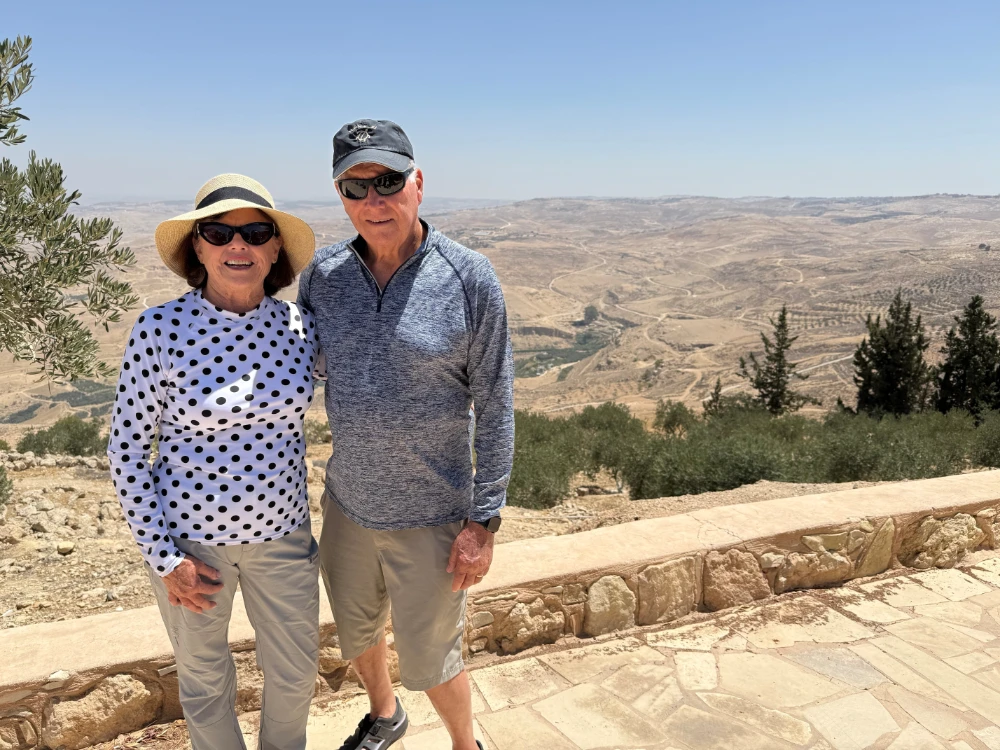
The next morning brought us to Mount Nebo, where God revealed the Promised Land to Moses and where Moses died and was buried in the valley below. The view was spectacular—we could see for miles across the land God had promised to His people. Standing there, we reflected on the poignant story of why God didn’t allow Moses to enter the Promised Land, recorded in Numbers 20:1-13. The Israelites had complained about lack of water, and God instructed Moses to speak to the rock to bring forth water. Instead, Moses struck the rock twice with his staff, and in his anger, he said “Must we bring you water out of this rock?” taking credit for the miracle instead of giving glory to God. In Deuteronomy 32:51-52, God explained His decision: “because you broke faith with me in the presence of the Israelites at the waters of Meribah Kadesh in the Desert of Zin and because you did not uphold my holiness among the Israelites”. Though it seemed harsh after Moses’s forty years of faithful leadership, God’s holiness required that Moses be held to the highest standard as the leader of His people. Yet God showed His compassion by allowing Moses to see the Promised Land from Mount Nebo before his death, and Deuteronomy 34:4-5 records God’s tender words: “This is the land I promised on oath to Abraham, Isaac and Jacob… I have let you see it with your eyes, but you will not cross over into it”.
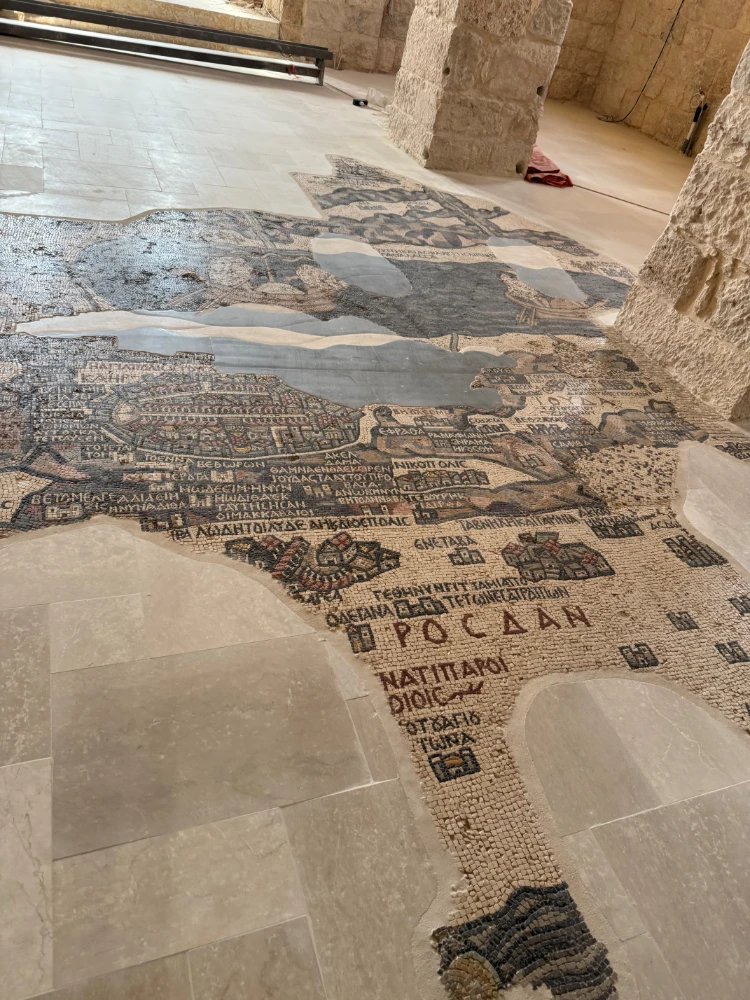
Next we visited the Church of St. George, which houses the world’s oldest map, made entirely of mosaics and incredibly well-preserved. This extraordinary Madaba Map, discovered in 1884 when the church was being built, dates from the 6th century AD and is the oldest surviving cartographic depiction of the Holy Land.
The massive mosaic originally measured 21 by 7 meters and was created from over two million mosaic stones in various shades of red, blue, and green. Though only about a quarter of the original map survives today, it still depicts an amazing level of detail covering the area from Lebanon in the north to the Nile Delta in the south, with Jerusalem prominently featured at its center. You can clearly see the Church of the Holy Sepulchre, the Damascus Gate, and other biblical sites with remarkable accuracy. The map served not just as geographic reference but as a spiritual guide for pilgrims, showing God’s salvation history through biblical geography.
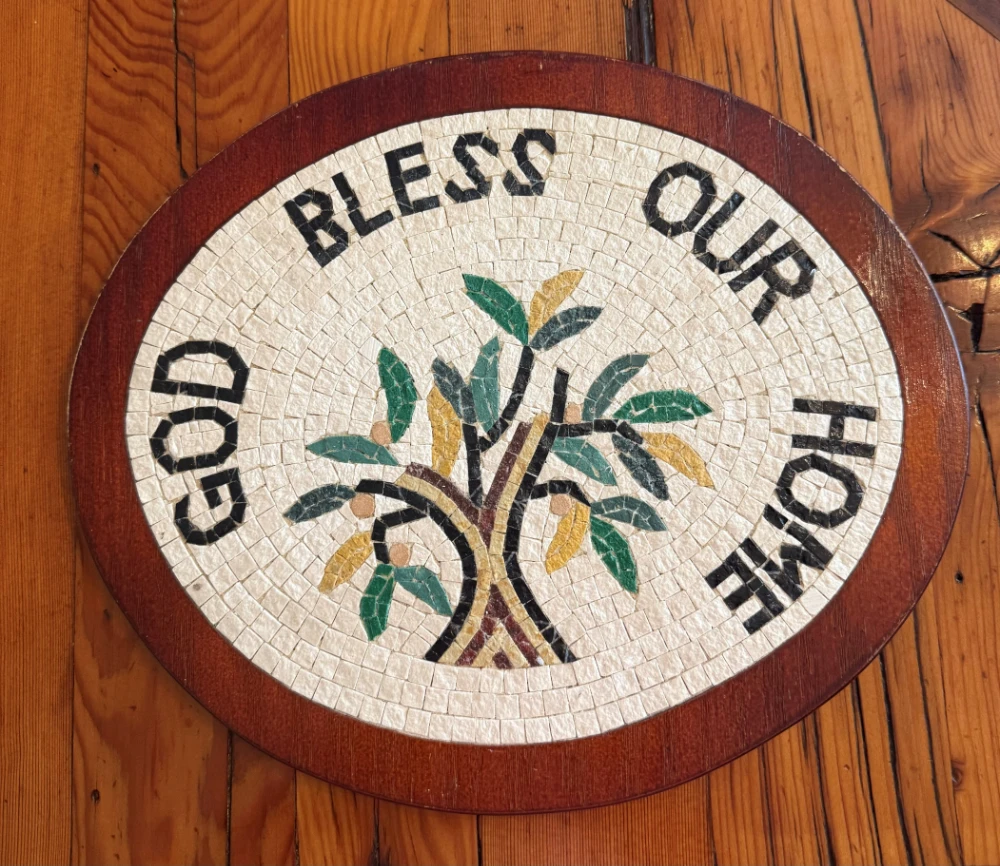
Finally, we had our first real opportunity to shop for souvenirs. Among other things, we purchased a beautiful plaque made of mosaics that says, “God Bless Our Home”. We watched artisans demonstrate the incredibly tedious process of creating these works of art from natural stone mined in Jordan. This plaque will now hold new meaning and occupy a place of honor and reverence in our home, reminding us daily of our incredible journey and God’s faithfulness. We had a flight scheduled to leave from Amman at 1:00 AM but God had other plans. It was canceled allowing us to have another remarkable day in Jordon.
Baptism in the Jordan River
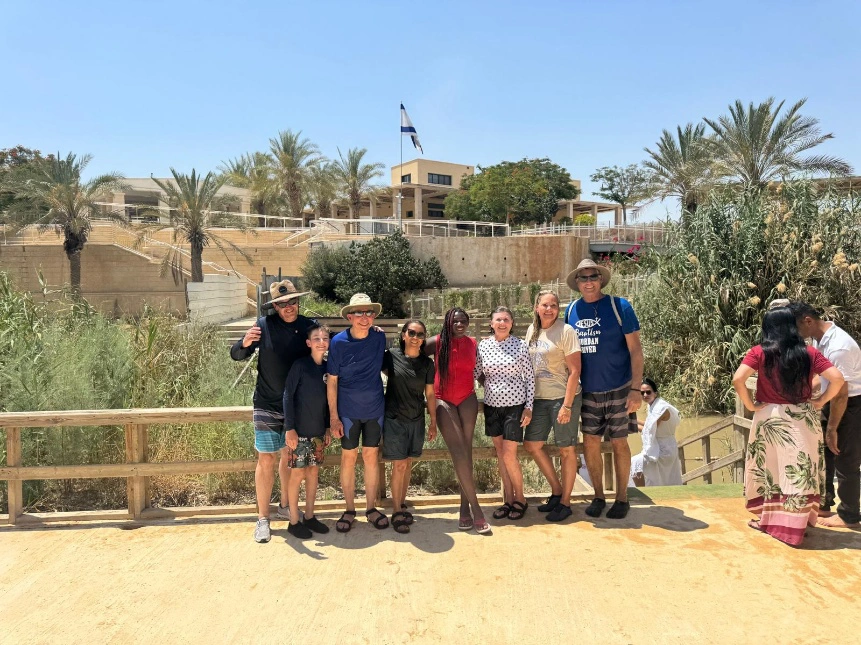
The highlight of our entire journey came at the Jordan River, the same sacred waters where thousands of years ago, after Moses handed leadership over to Joshua, God performed another miracle. Following forty years of wandering in the wilderness, Joshua led the Israelites across this very river into the Promised Land. God stopped the flow of the Jordan River, allowing His people to cross on dry ground while carrying the Ark of the Covenant. Once the Ark was safely on the other side, Joshua instructed the leaders of the twelve tribes to collect twelve stones from the riverbed and erect a monument to show future generations the faithfulness of God and how He had delivered His people. This is especially meaningful to us because this is why we named our ministry Standing Stone. These stones were to serve as a lasting memorial and testimony to God’s faithfulness for all who would see them – monuments that would declare His mighty works for generations to come.
Finding ourselves at this same river, we were deeply moved by the continuity of God’s faithfulness from ancient times to our present moment. It was sweltering. The muddy river is about 30 feet wide and we could see the baptismal site on the Israeli side usually packed with others being baptized, now eerily vacant. Seven people from our group were baptized. They saved Debbie for last. As she entered the water with Jeremy preparing to baptize her and Jim by her side, a Jordanian soldier with a semi-automatic weapon approached and said we had to leave immediately. We had gone past the allowed time for a group to be in the baptismal site. But nothing—absolutely nothing—was going to get Debbie out of that water before she was baptized in the same river where Jesus was baptized by John the Baptist. It also gave new meaning to the phrase “baptized with fire”—being baptized in the Jordan River with an armed soldier telling you to leave, in sweltering heat, in a war zone, while missiles were being fired nearby.
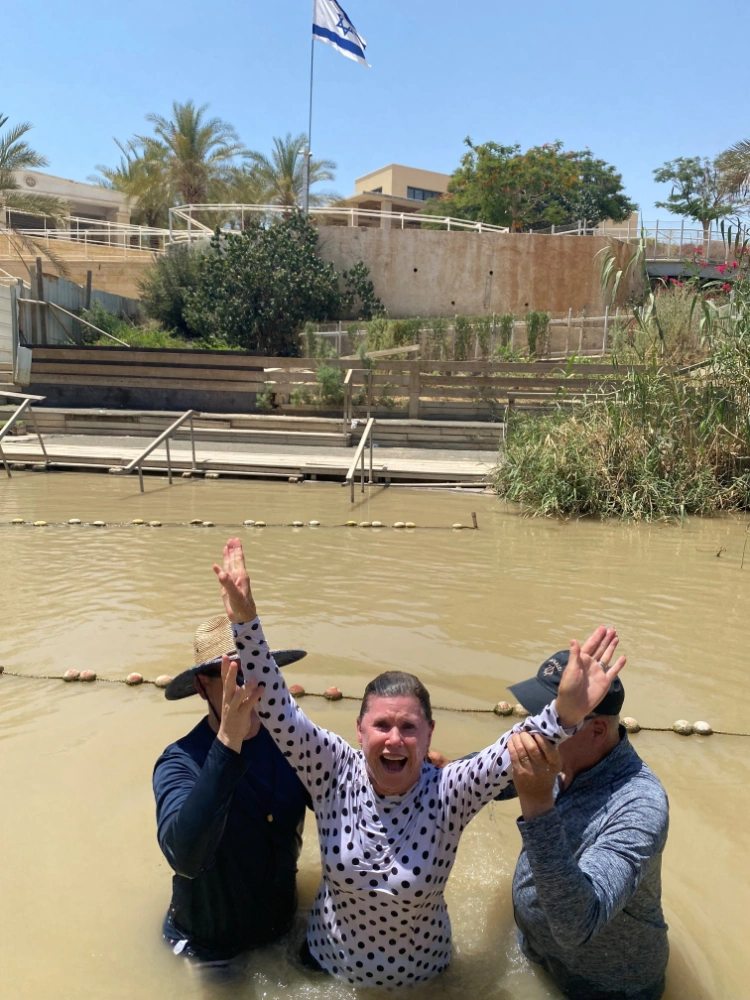
When she emerged from the water with her hands raised in victory and praise, our entire group erupted in cheers. It was a moment of pure joy and spiritual triumph that captured the essence of our entire fifty-six-year journey.
The Long Journey Home
After a long bus ride back to Amman, the rest of our group prepared to spend another night while we were prepared for a flight leaving at 1:00 AM. We showered, had our final dinner with the group, and shared heartfelt, tearful goodbyes with people who had been strangers just a week before but now felt like forever family. Along with the Clarks and Miraldis, we said our goodbyes.
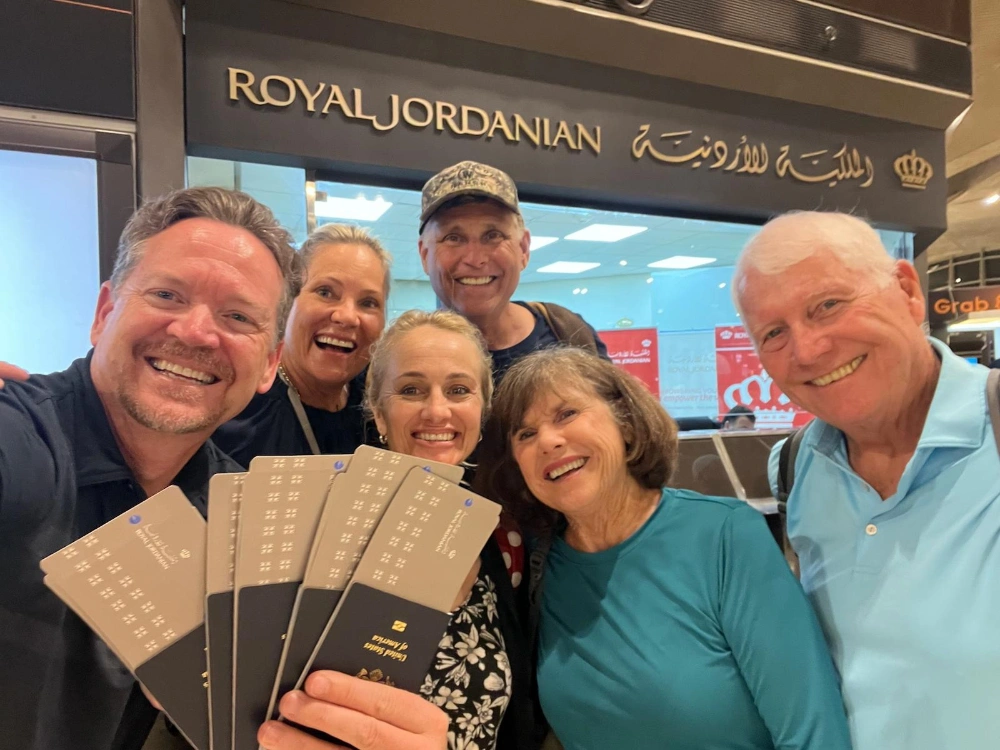
Not knowing what to expect at the Amman airport, we arrived four hours early, praying our flight would not be canceled. We navigated immigration with minimal trouble (except for confusion about visas we already had) and endured the long wait before finally boarding our Royal Jordanian plane for a four hour flight to Qatar.
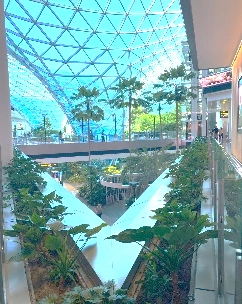
The Qatar airport was magnificent, filled with top designer stores and even a Harrods tea house, but we were too exhausted to do anything but wait four hours for our connecting flight home. What was supposed to be a 14-hour flight to the USA turned into 17 hours because we had to fly around the war zone. As we took off, we flew over the Persian Gulf where battleships lined up, preparing for what was about to unfold.
When we finally landed at LAX, the entire plane erupted in applause. It has never felt so good to be on American soil!
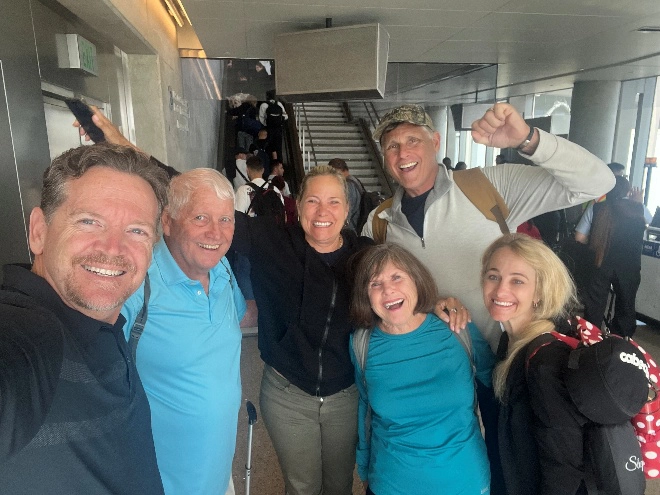
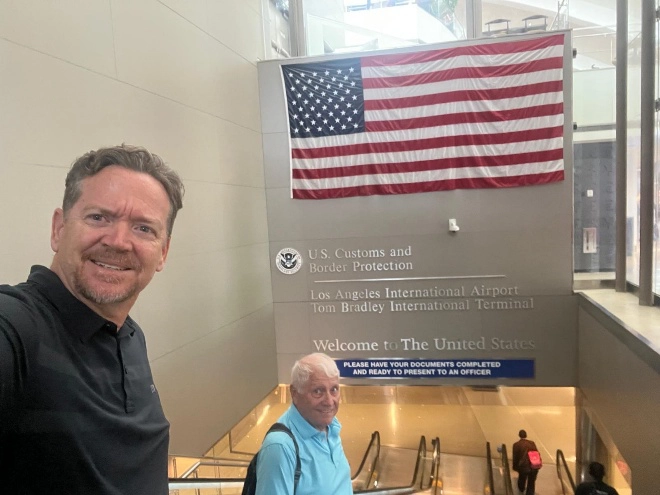
Reflections on an Extraordinary Journey
Just two days after our return, the U.S. military hopefully completely eliminated Iran’s ability to develop atomic weapons. Will there ever truly be peace between Israel and Iran? We can only hope, pray, and wait and see.
This trip has changed us forever. It made the Bible come alive in ways we never imagined possible. Walking where Jesus walked, where He lived, where He died, and where He rose again so that we could live forever with Him transformed our faith. We gained a new perspective on the people of Israel—their courage, resilience, and pride in their country. Meeting Palestinians, Christians, and Jews made us realize that despite our different views, deep inside we are all the same—we are all people created in God’s image.
The hardest part of the trip was knowing how worried our families were back home. The only time Debbie cried was when she could hear the fear in our family’s voices during our phone calls. But it was also the first time we truly felt covered by the prayers of so many people. We will never know just how many prayed for us, but we felt every single one, and God heard them all.
We saw many olive trees during our journey. Though we will never know if any were the ones planted in memory of Debbie’s parents so many years ago, we fulfilled our dream to visit the land where those trees are flourishing now. Hopefully someday we will return to see the Sea of Galilee and the places where Jesus did most of His teaching. But for now, we’re content knowing we finally fulfilled that long-held dream, honored the memory of Debbie’s parents, and experienced the Holy Land in a way that deepened our faith beyond measure.
After fifty-six years, five cancellations, war alerts, bomb shelters, and a baptism in the Jordan River, we understand now that God’s timing truly is perfect.
The Brulte Family’s Priceless Gift
We cannot conclude this account without expressing our deepest gratitude to Jim and Kirsten Brulte and their precious daughter Ivy. When Jim gifted us this trip upon our transition of Standing Stone Ministry leadership to Jeremy and Jerusha Clark, he had no idea he was becoming an instrument in God’s perfect timing. What seemed like a generous gesture from a dear friend was actually God orchestrating the fulfillment of a fifty-six-year-old dream at precisely the right moment.
Looking back now, we understand that we were called to be in Israel at “such a time as this”—the very words Mordecai spoke to Queen Esther when she was positioned to save her people: “For if you remain silent at this time, relief and deliverance for the Jews will arise from another place, but you and your father’s family will perish. And who knows but that you have come to your royal position for such a time as this?” (Esther 4:14).
Like Esther, we now believe God positioned us to witness His faithfulness during one of the most challenging periods in modern Israeli history. We were there not just as tourists or pilgrims, but as witnesses to His protection and provision in the midst of conflict. We experienced firsthand what it means to trust God when missiles are flying overhead, when sirens pierce the night, and when the world feels uncertain and dangerous. We learned that His peace truly does surpass all understanding, even in bomb shelters and war zones.
The Brulte family’s generosity became the key that unlocked God’s perfect timing. Through their gift, we were able to travel with dear friends who became family, support Israel’s struggling tourism economy during wartime, encourage local believers and business owners, and return home with testimonies that will encourage others for years to come.
Jim, Kirsten, and Ivy—we thank you from the bottom of our hearts for being God’s instruments in making this life-changing journey possible. You gave us far more than a trip; you gave us the opportunity to witness His sovereignty in action and to understand that His timing is always perfect, even when dreams take fifty-six years to unfold.
Thanks to the Brulte’s, our journey to the Holy Land is complete, but the impact of those eleven days will last for eternity. When we landed together at LAX, we were loving each other even more than when we took off. “The Stoners” had become forever family, bonded by an extraordinary experience that none of us will ever forget. We couldn’t have asked for better companions on this epic adventure.
God’s faithfulness endures forever, and sometimes He uses the generosity of dear friends to orchestrate the fulfillment of dreams we’ve carried for a lifetime.
